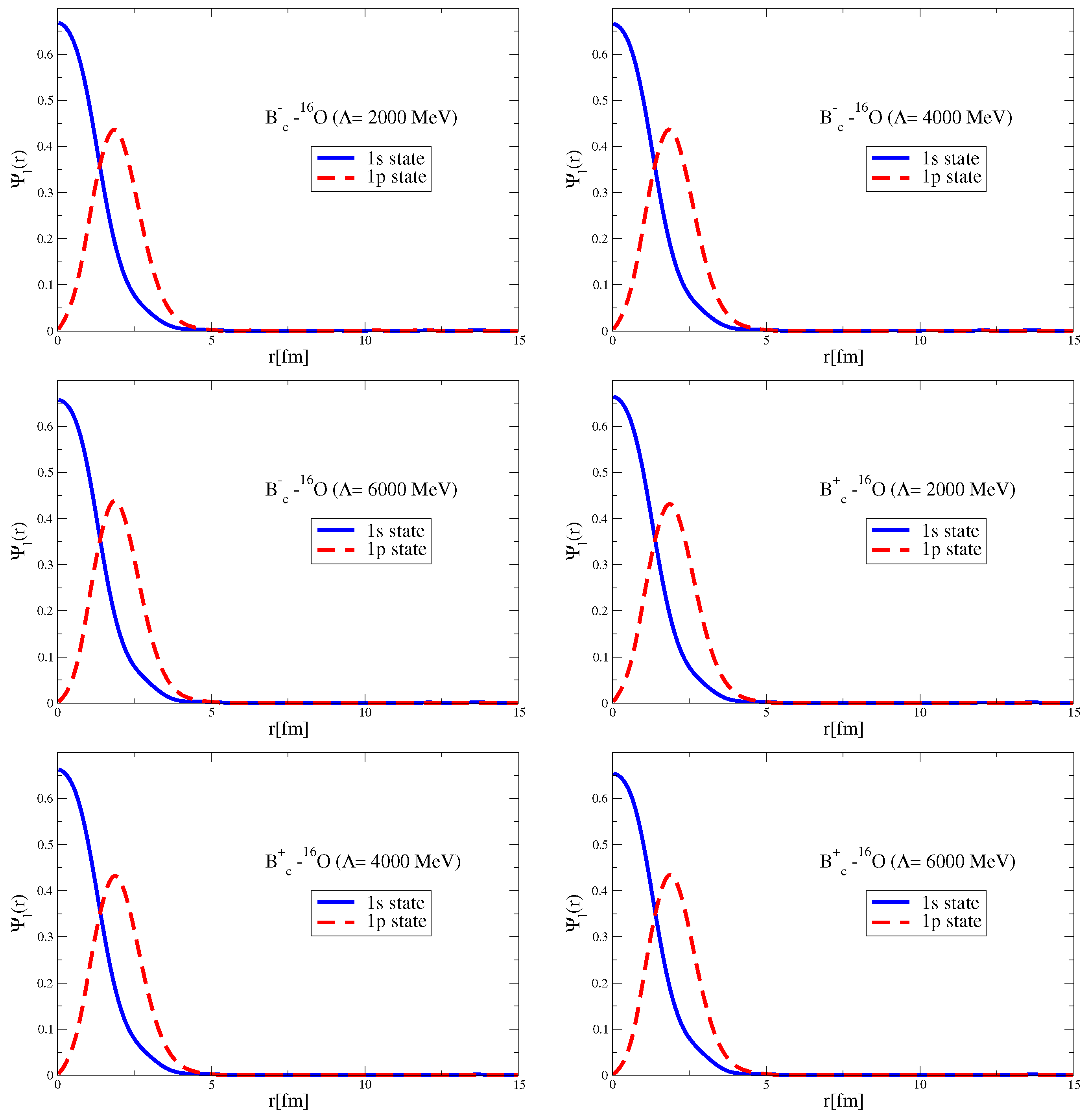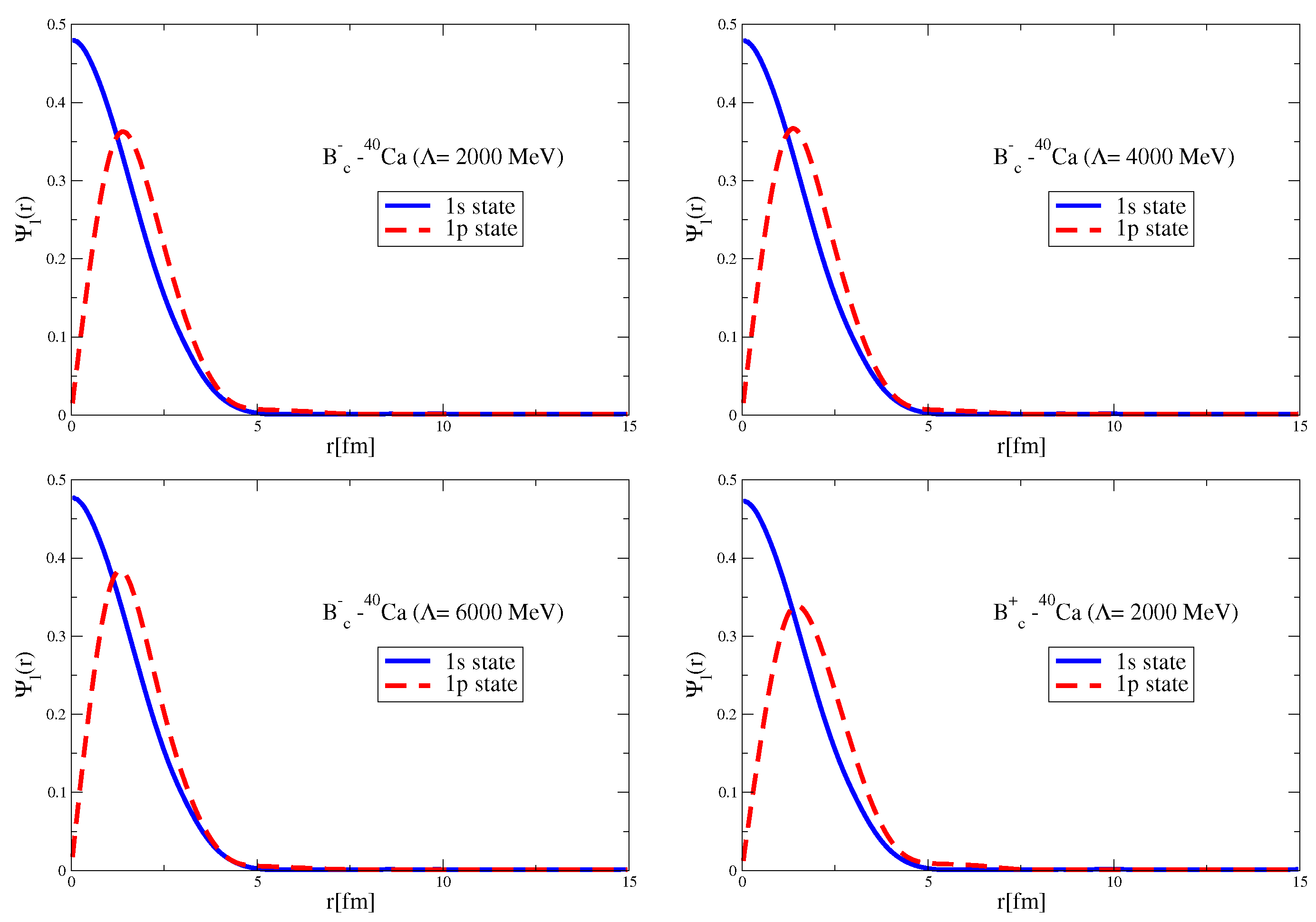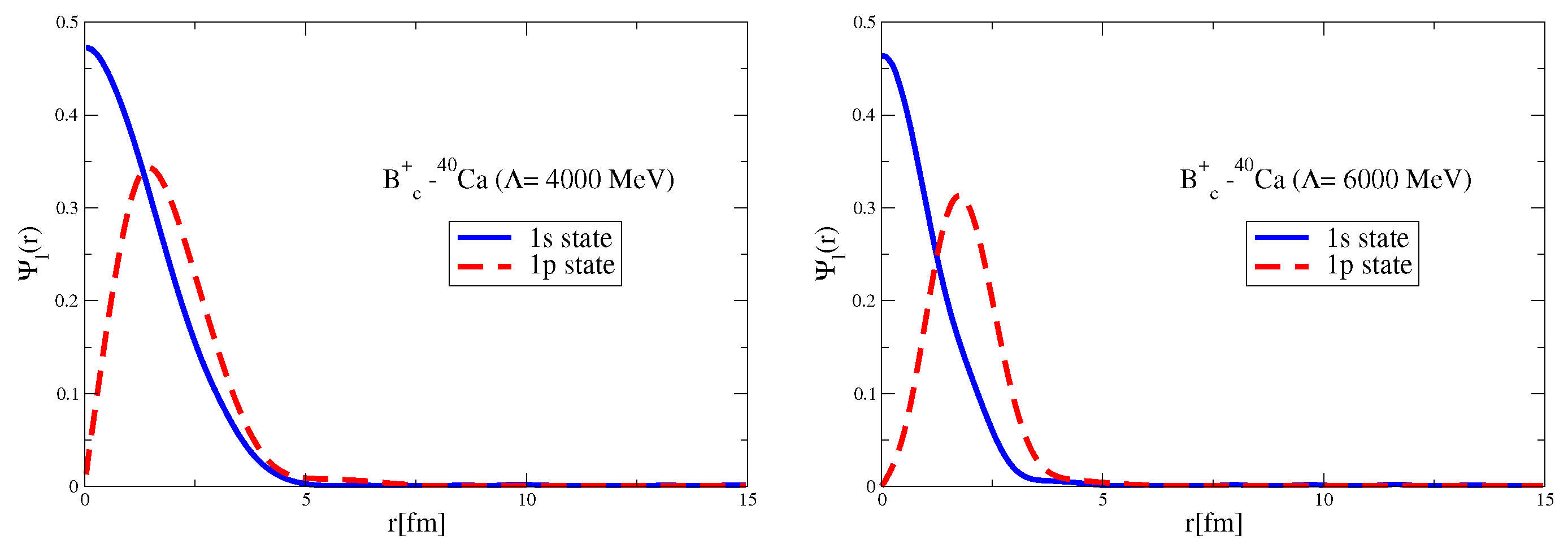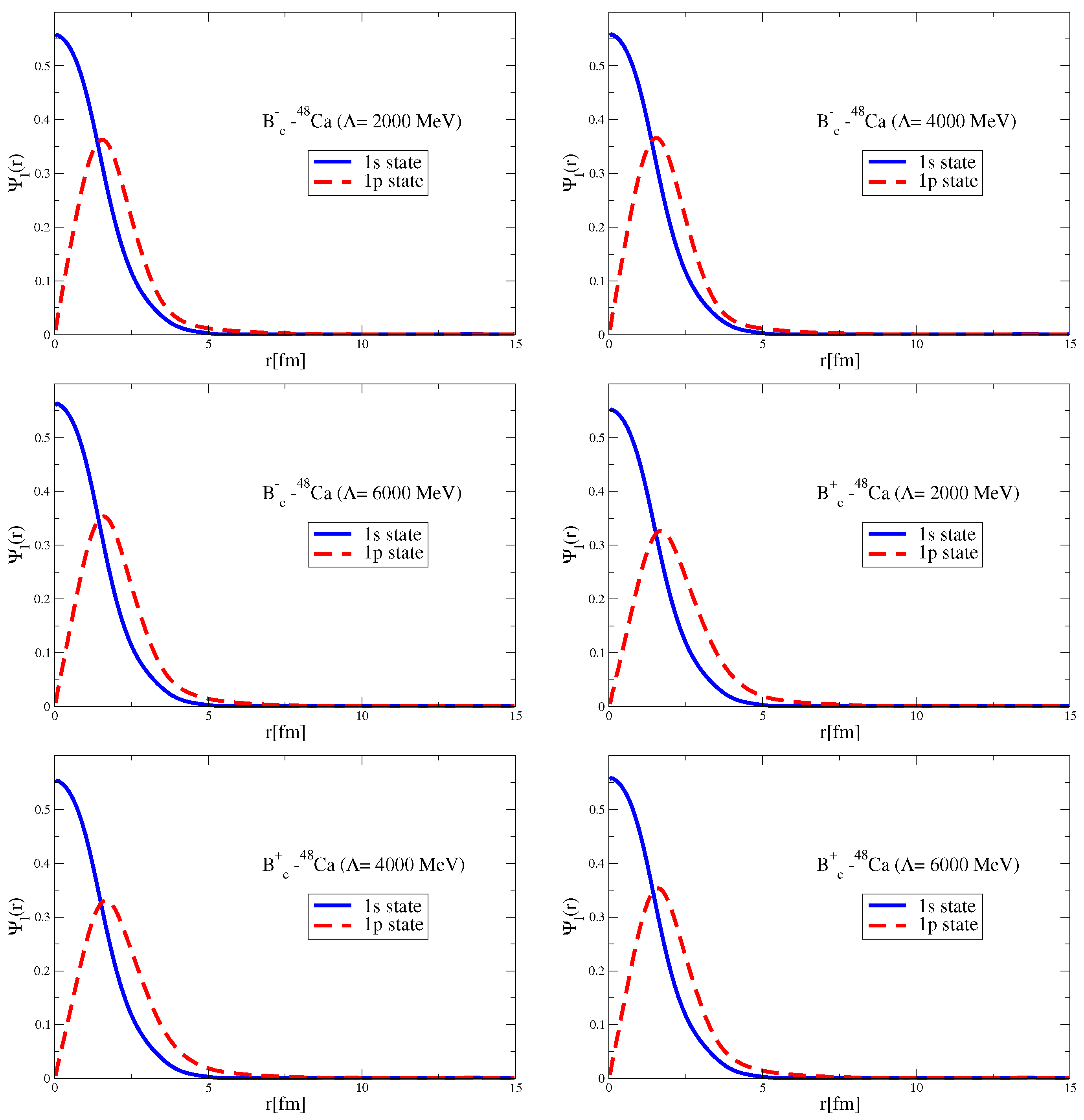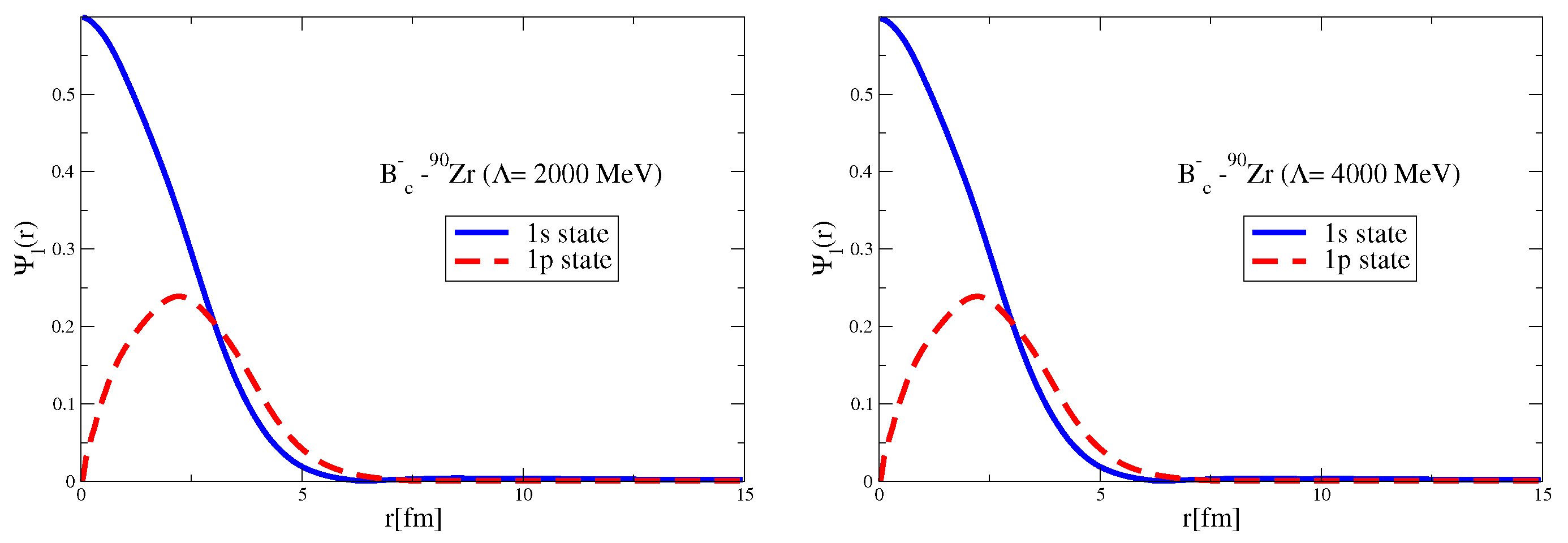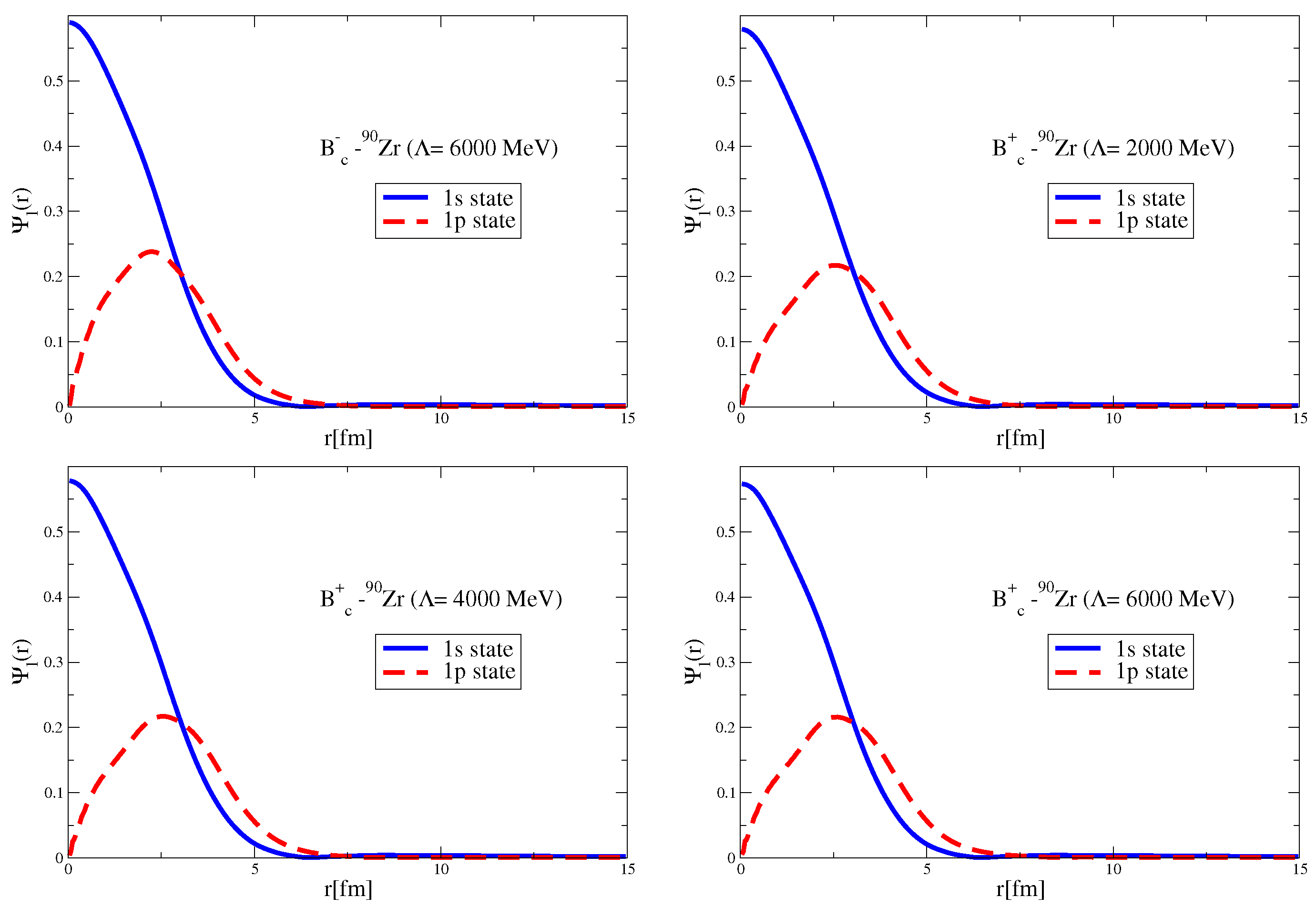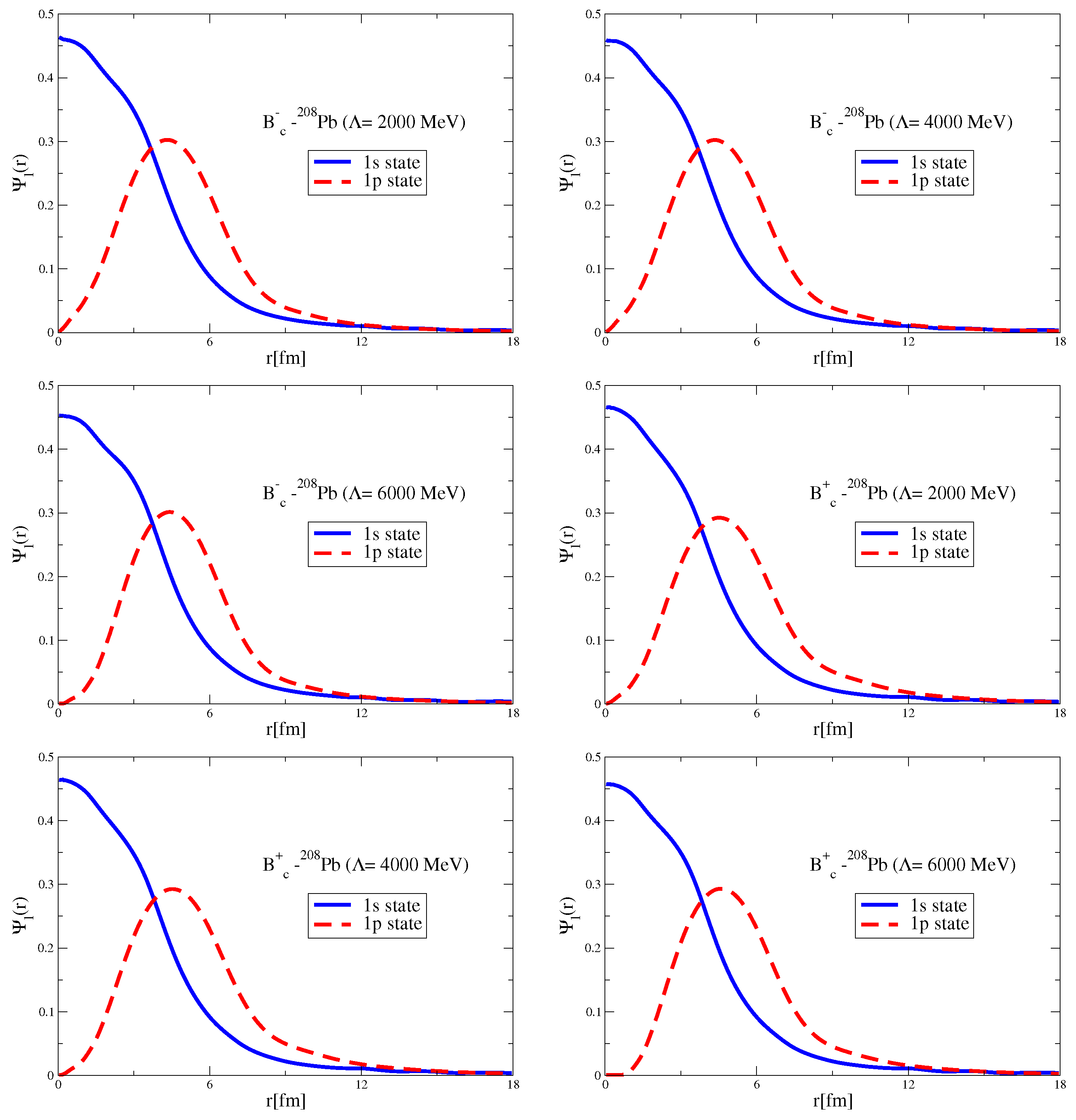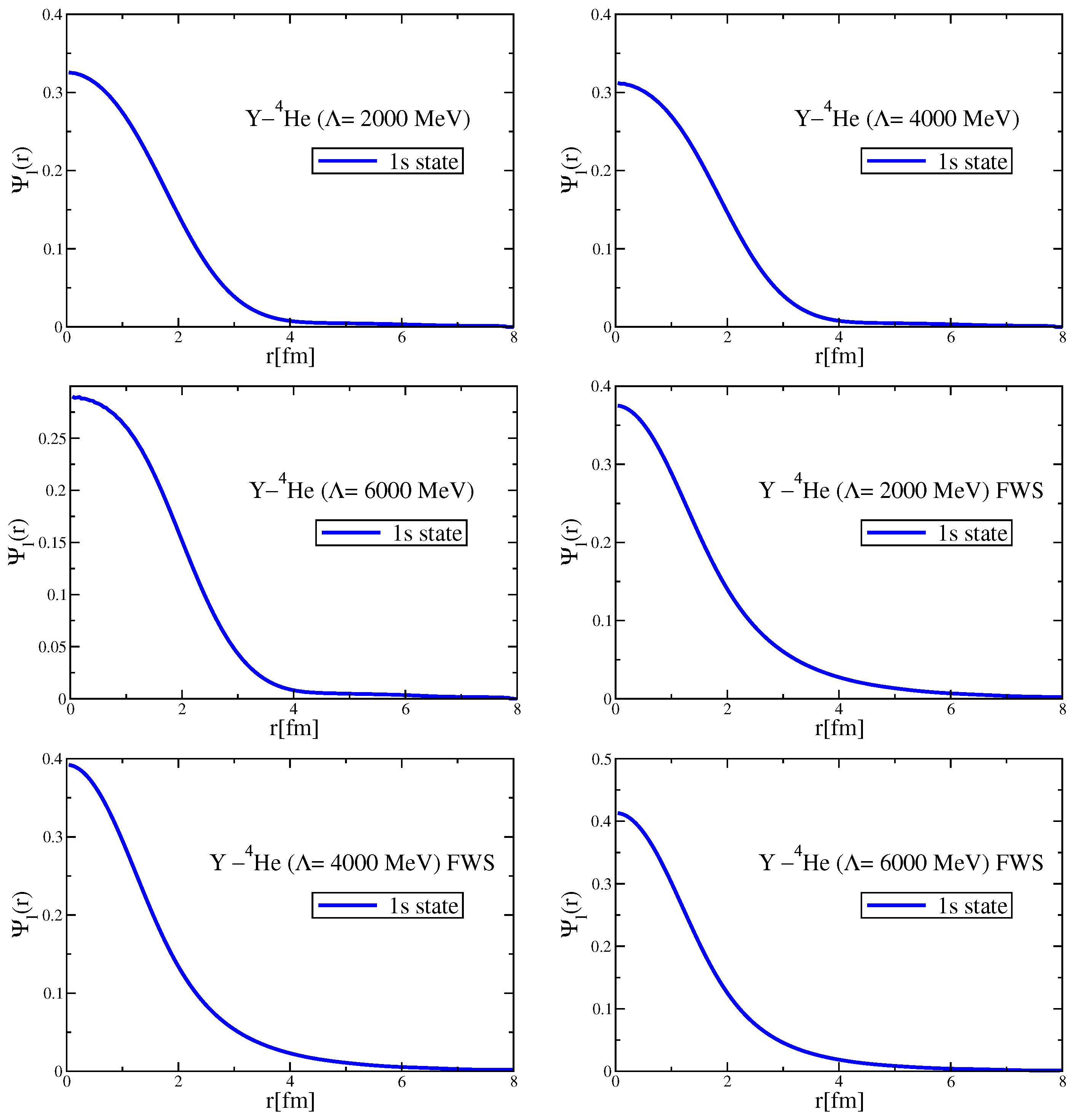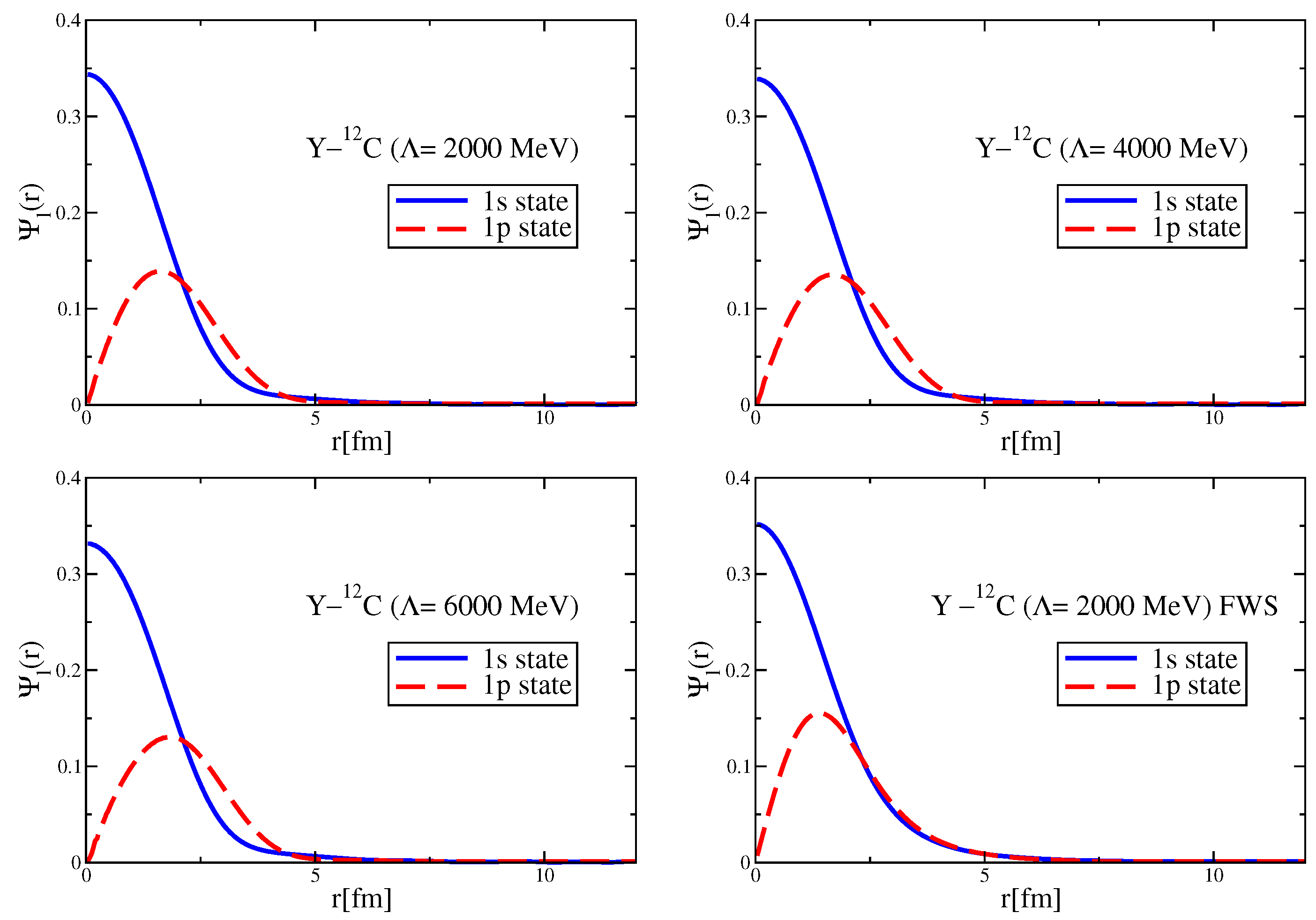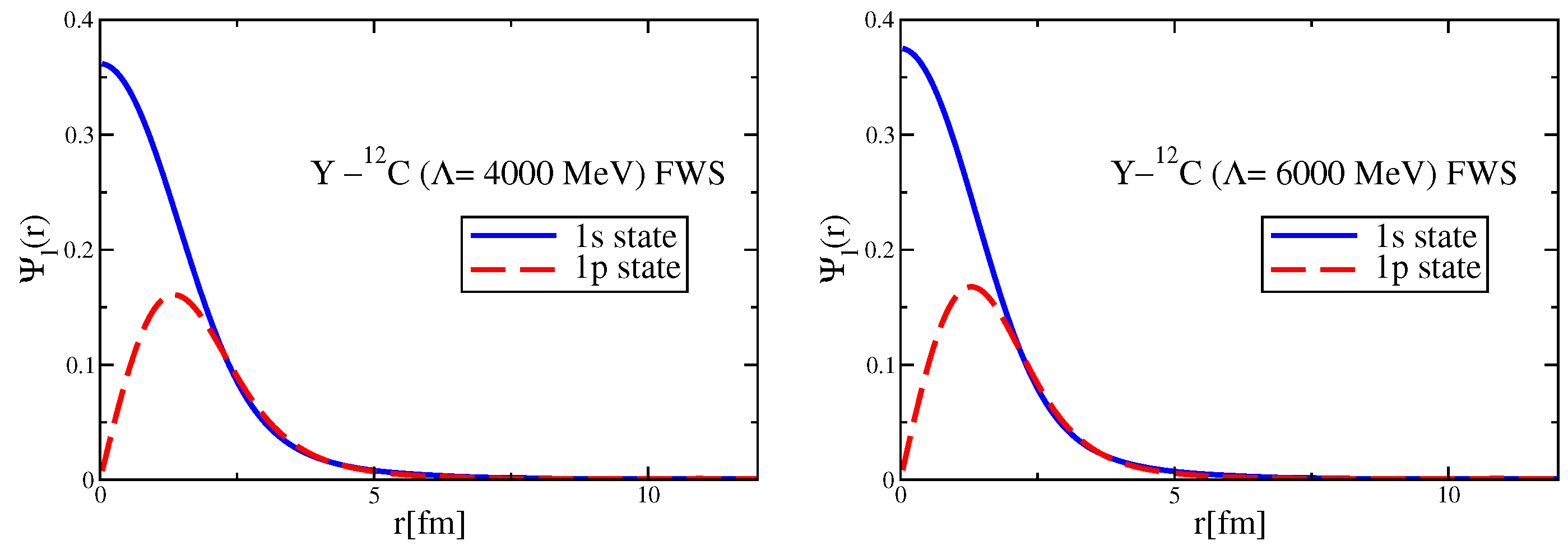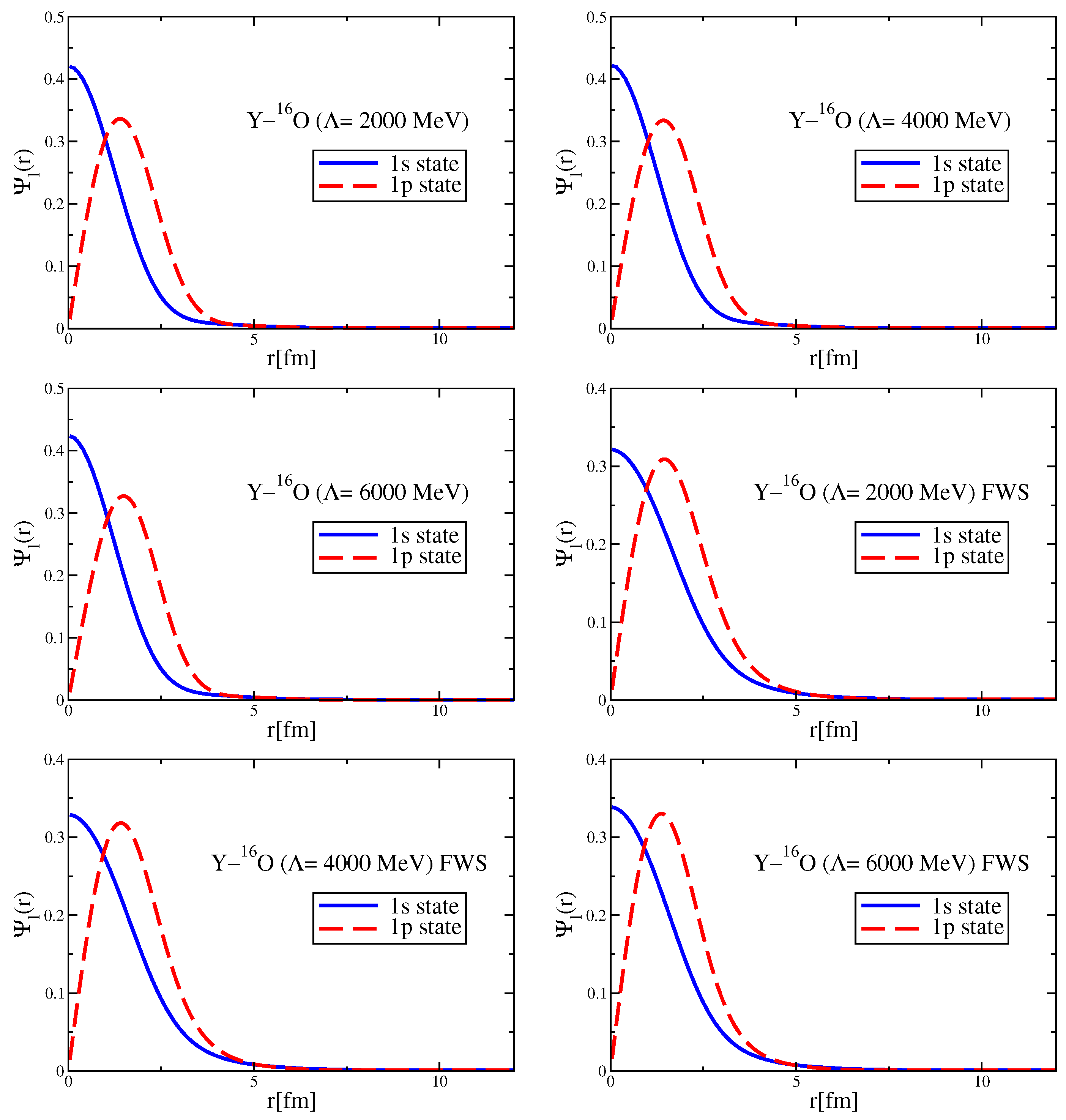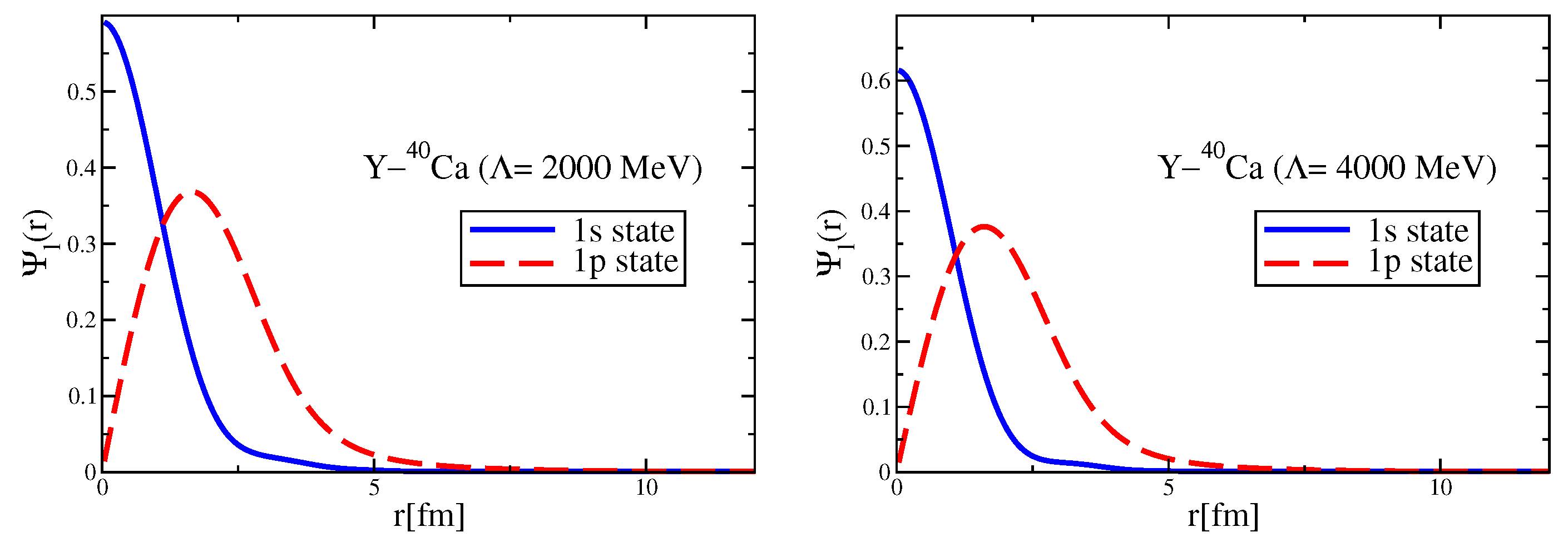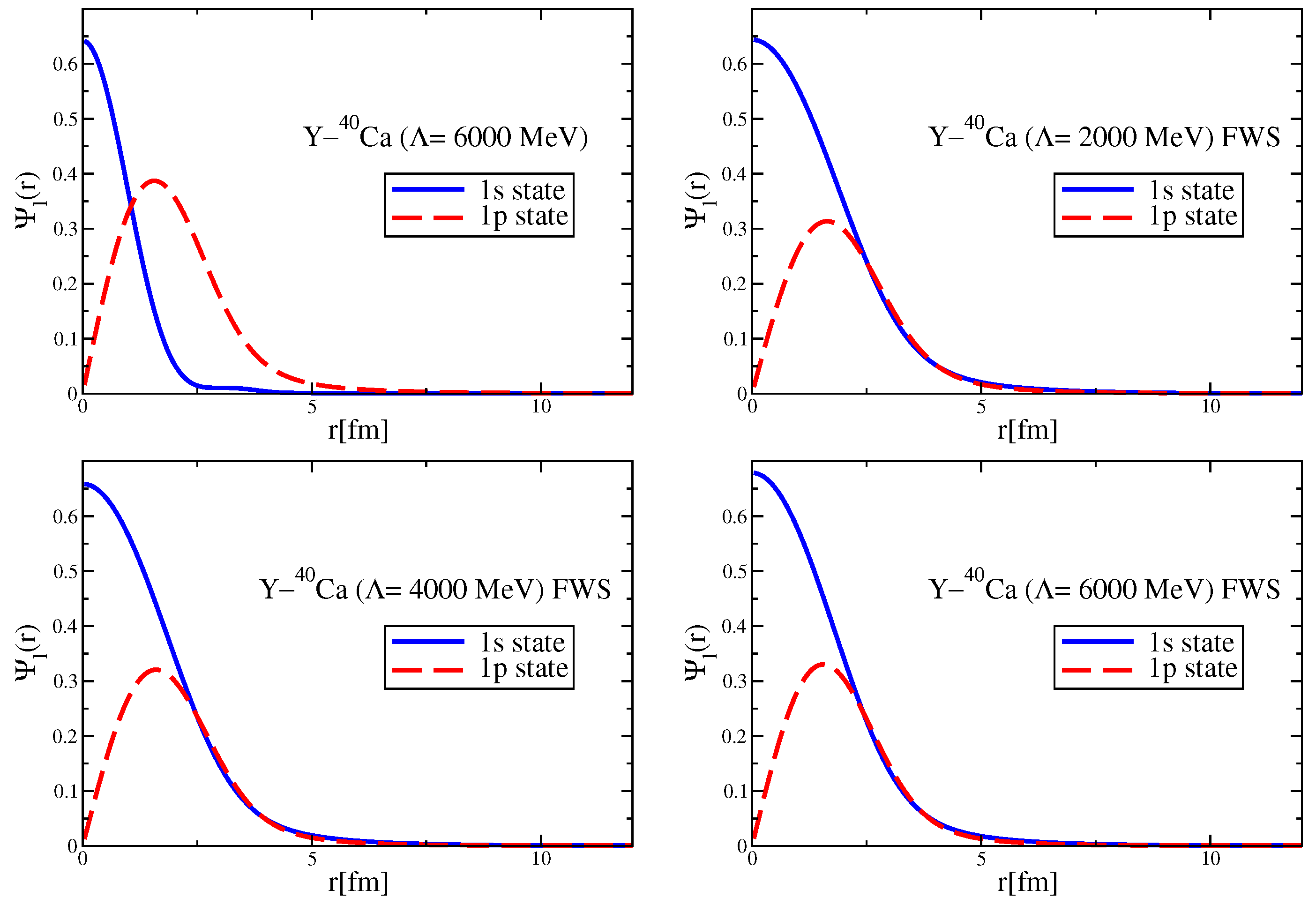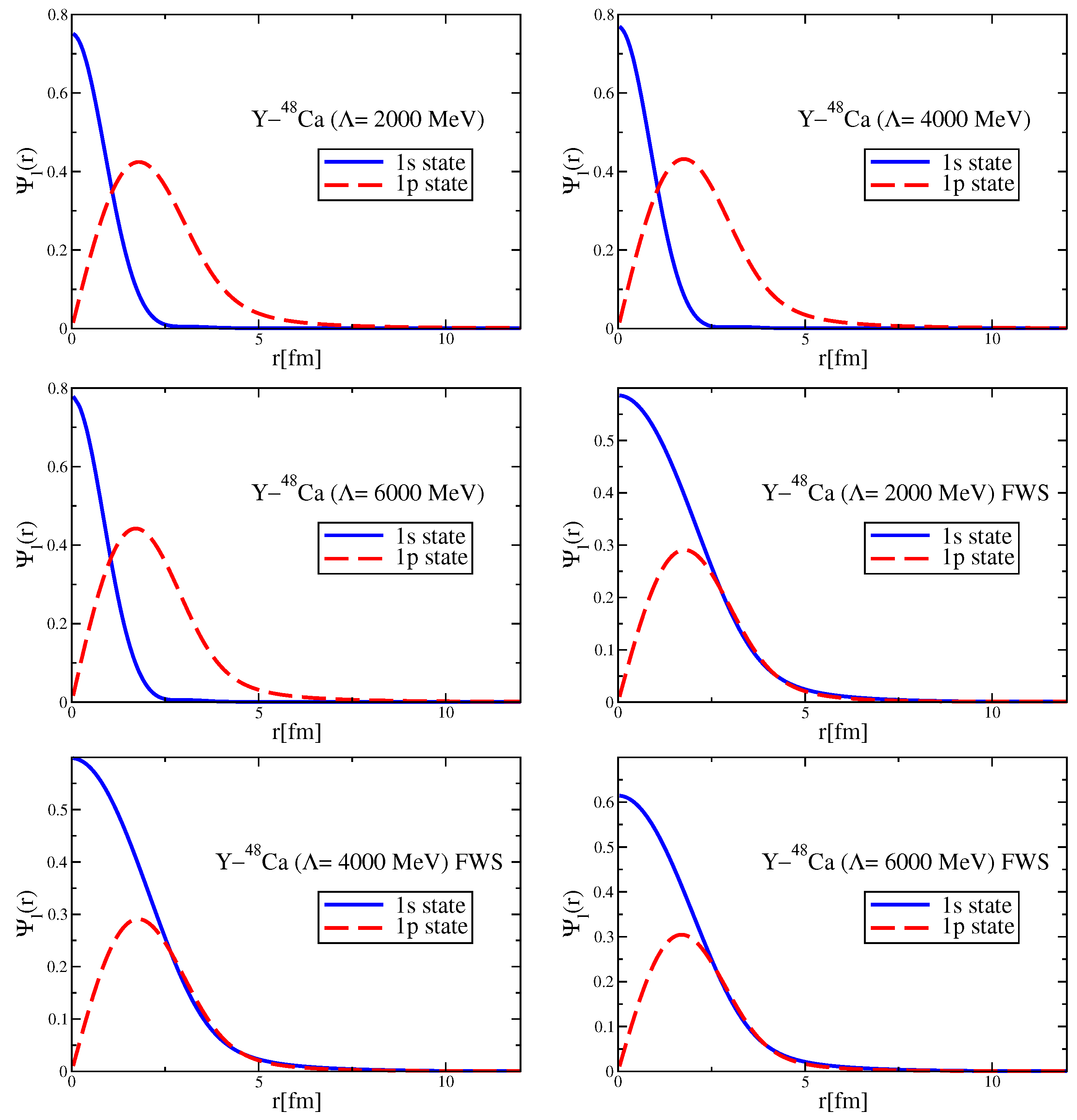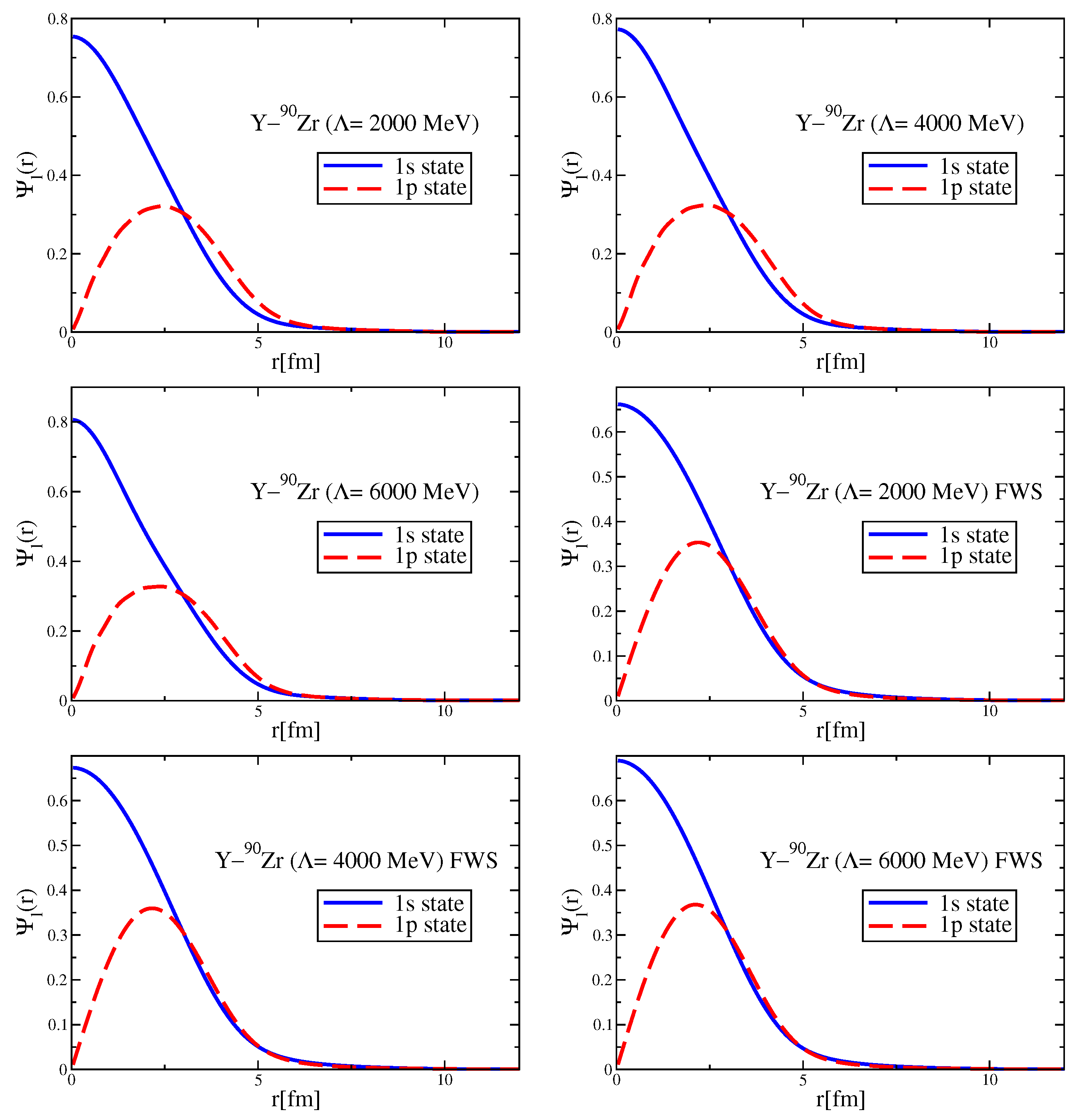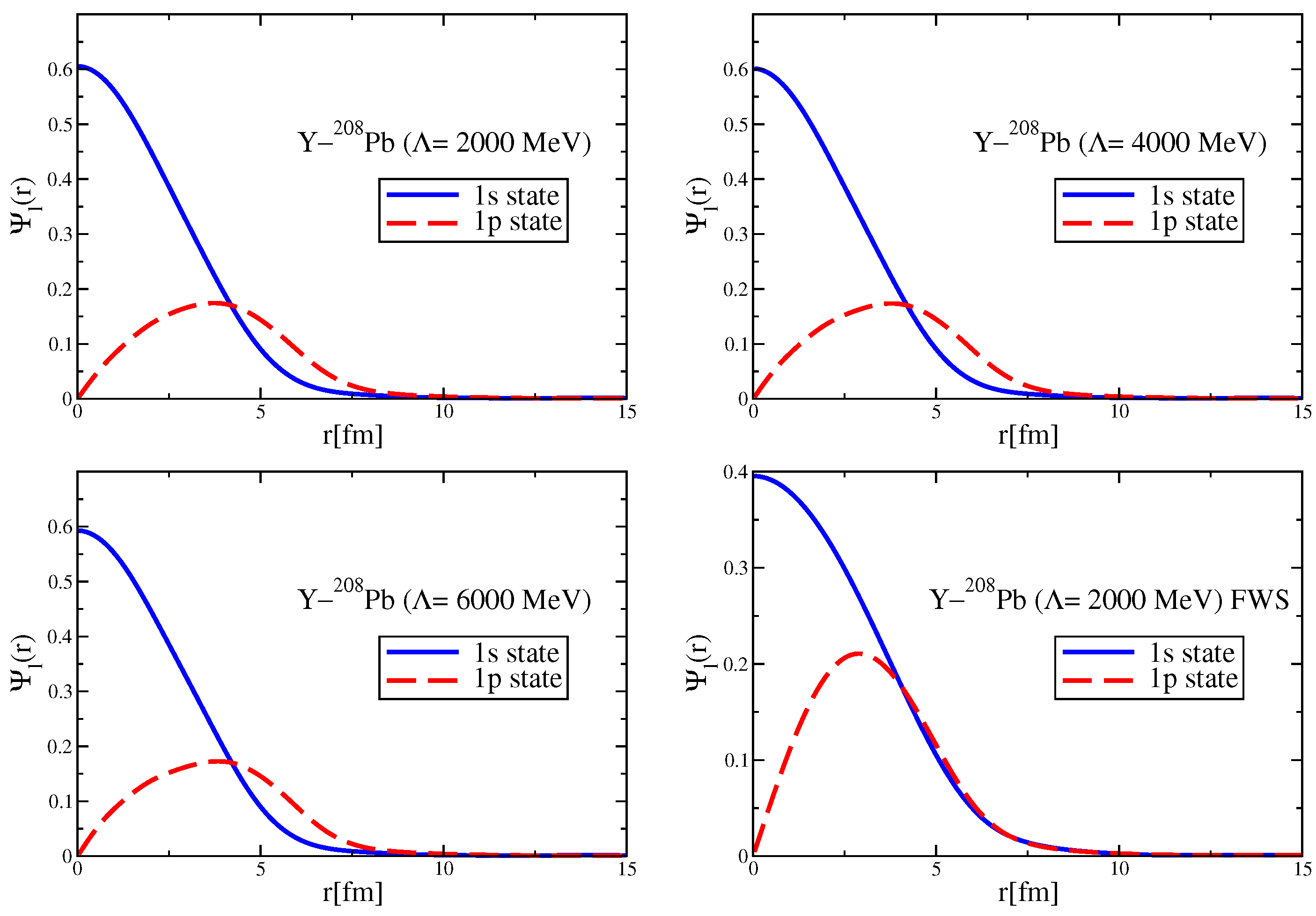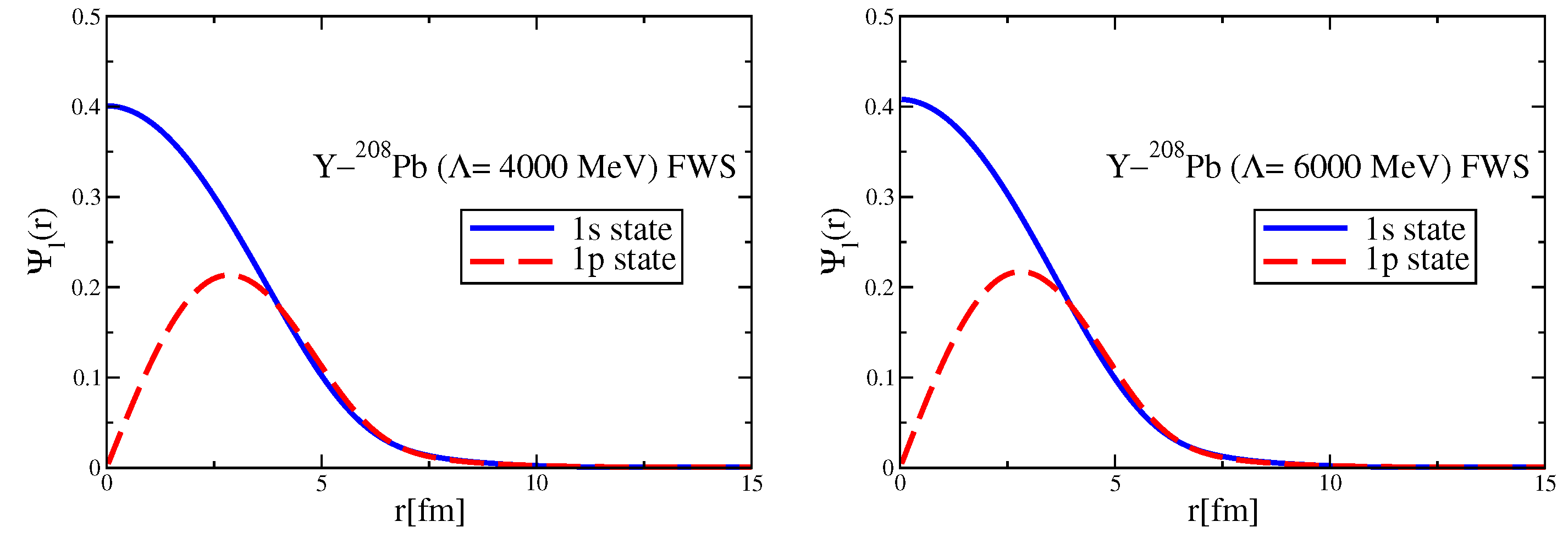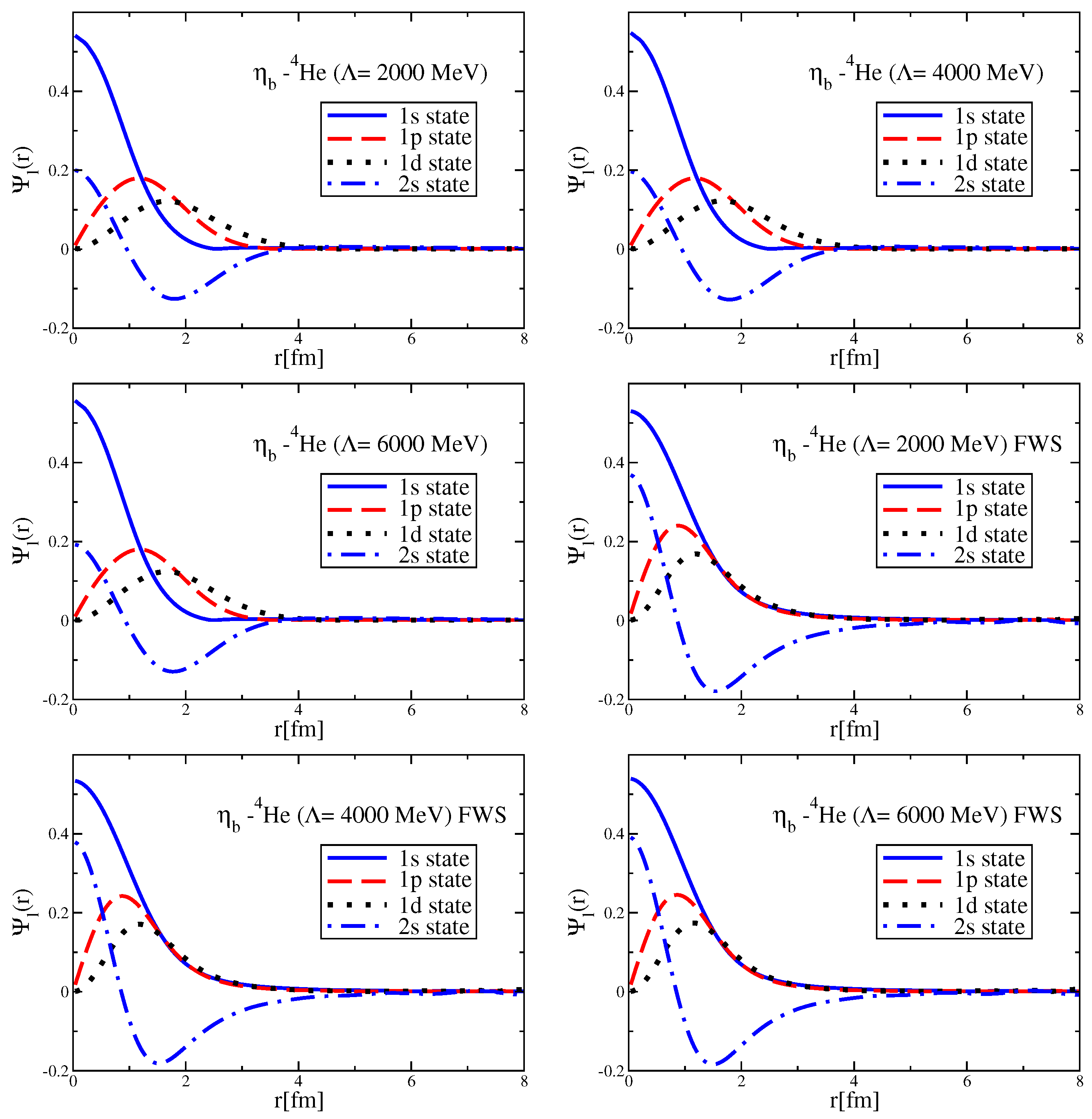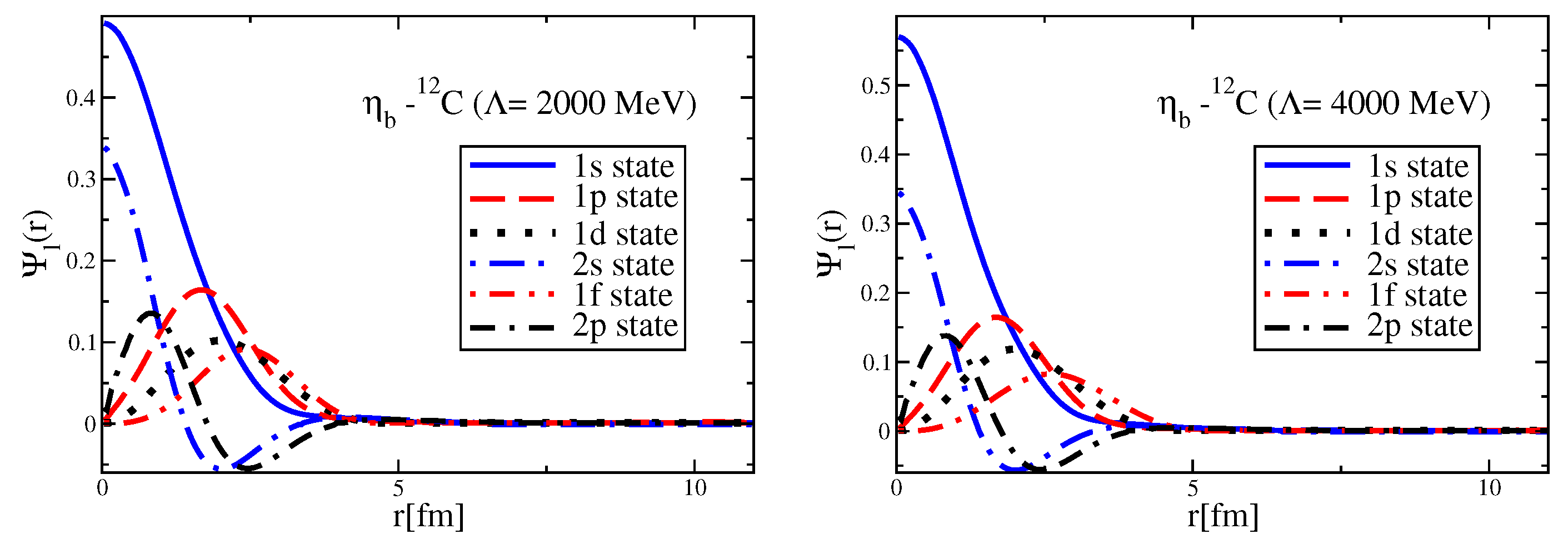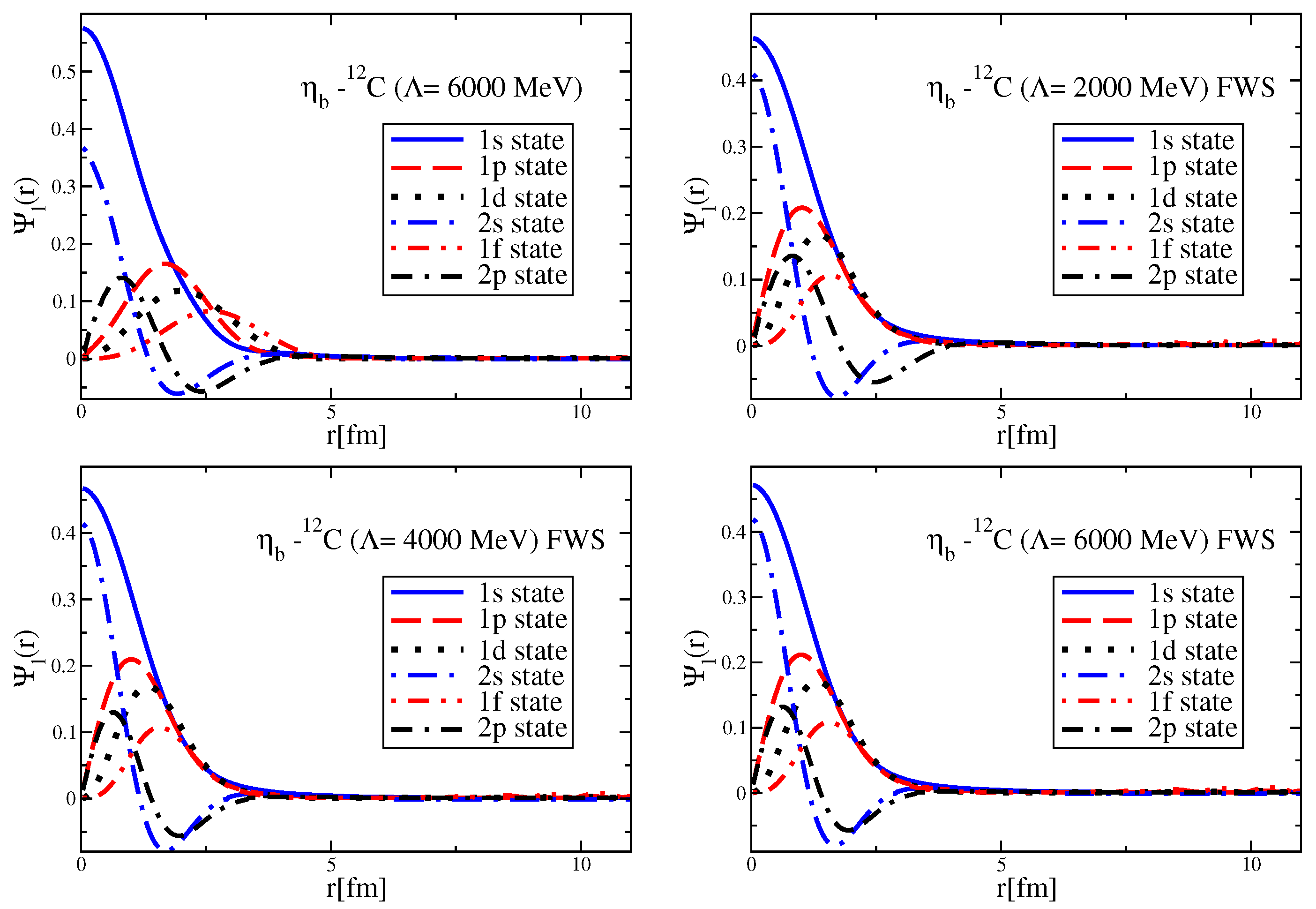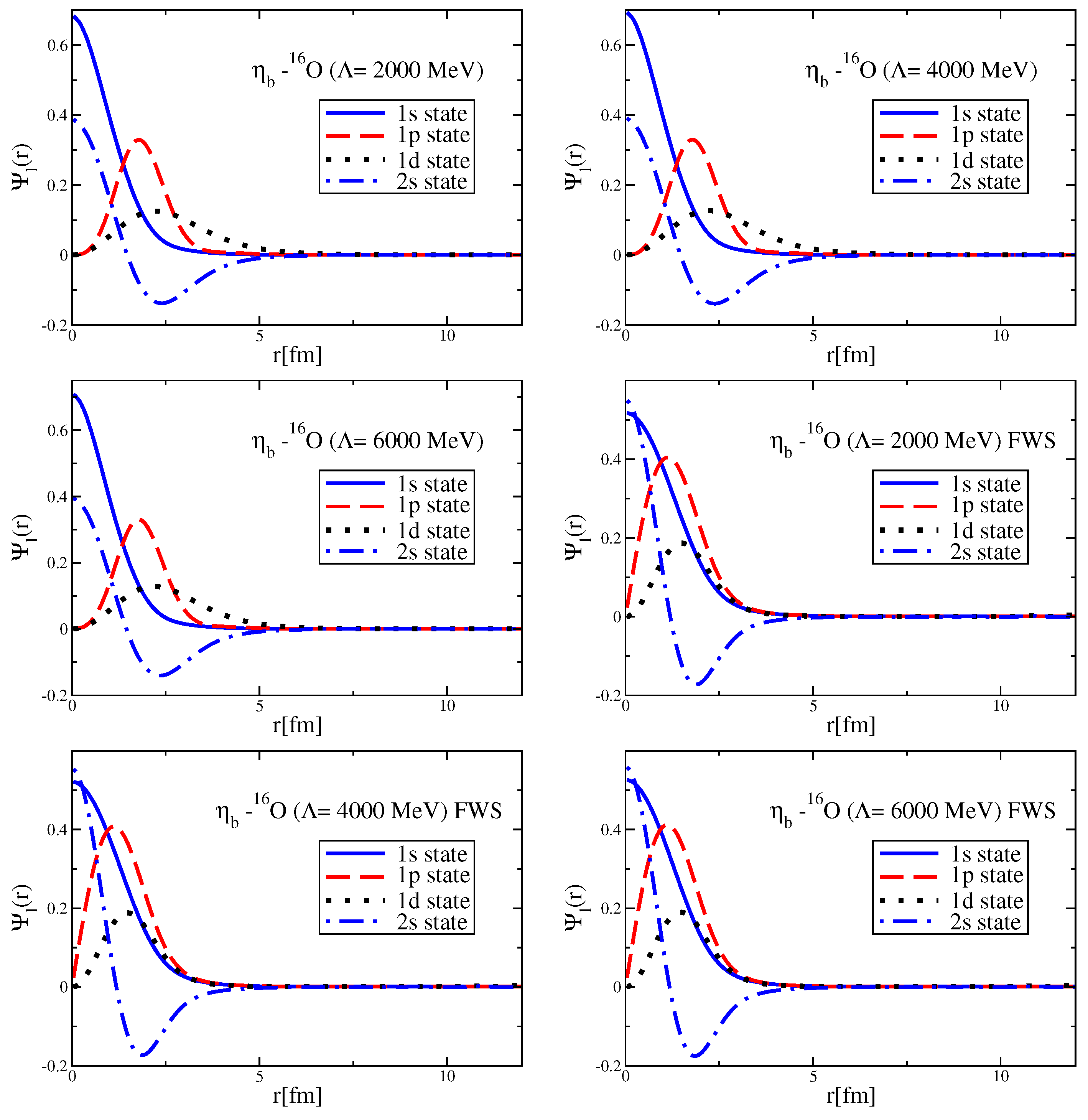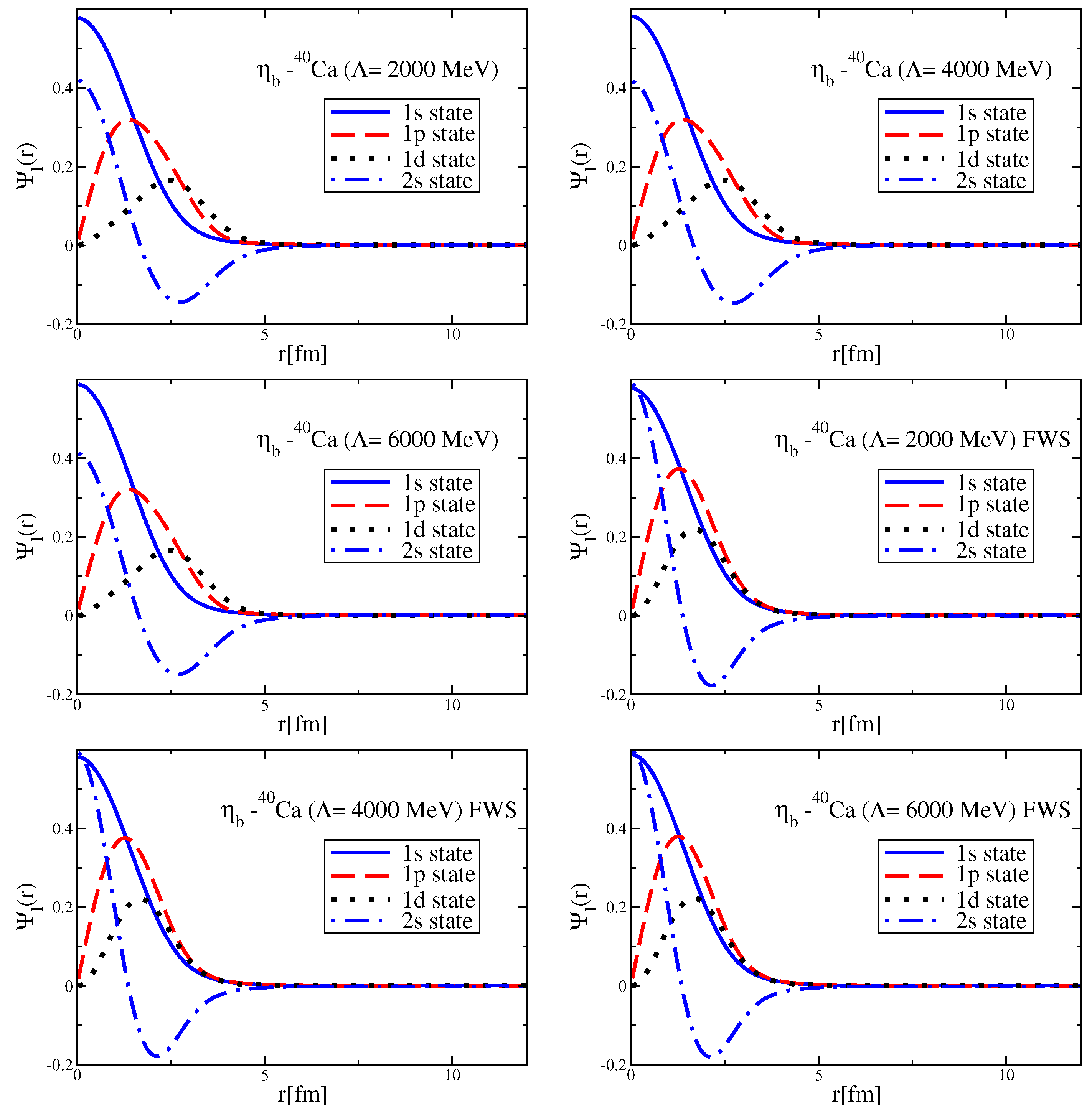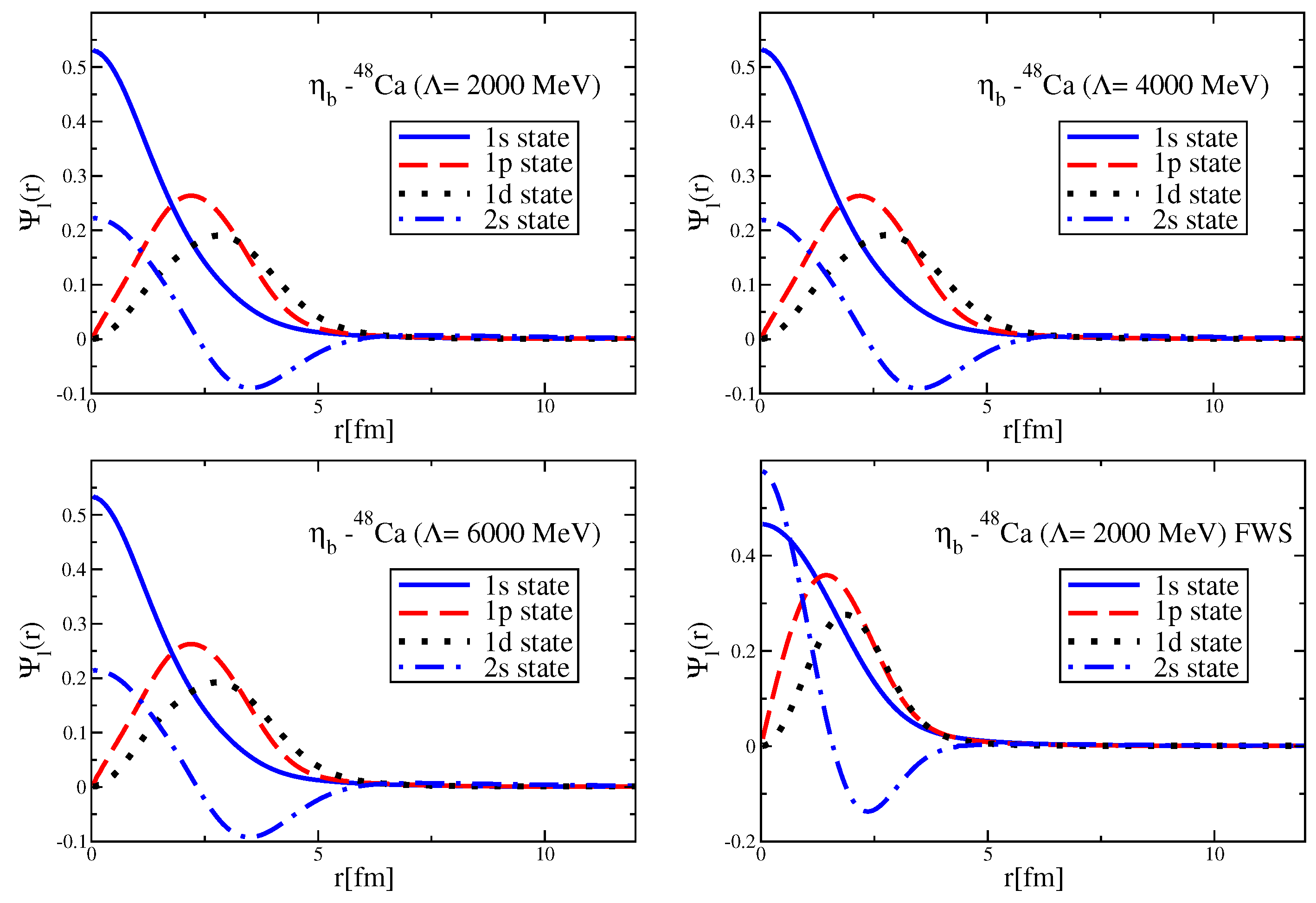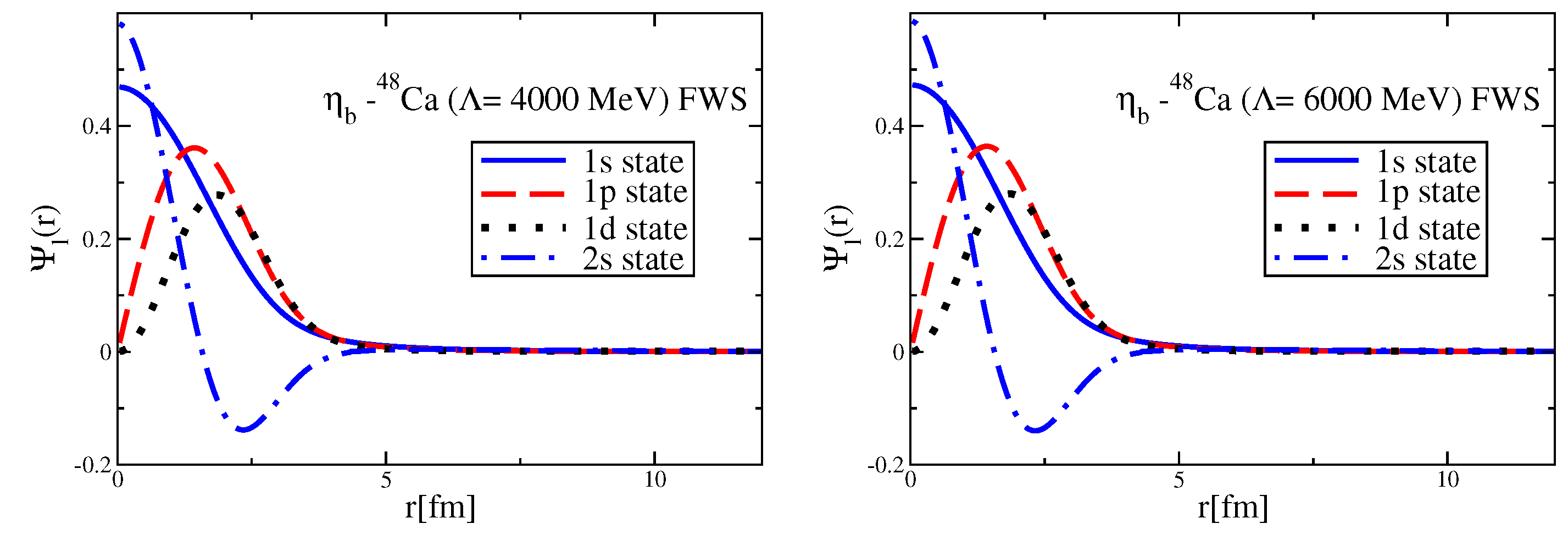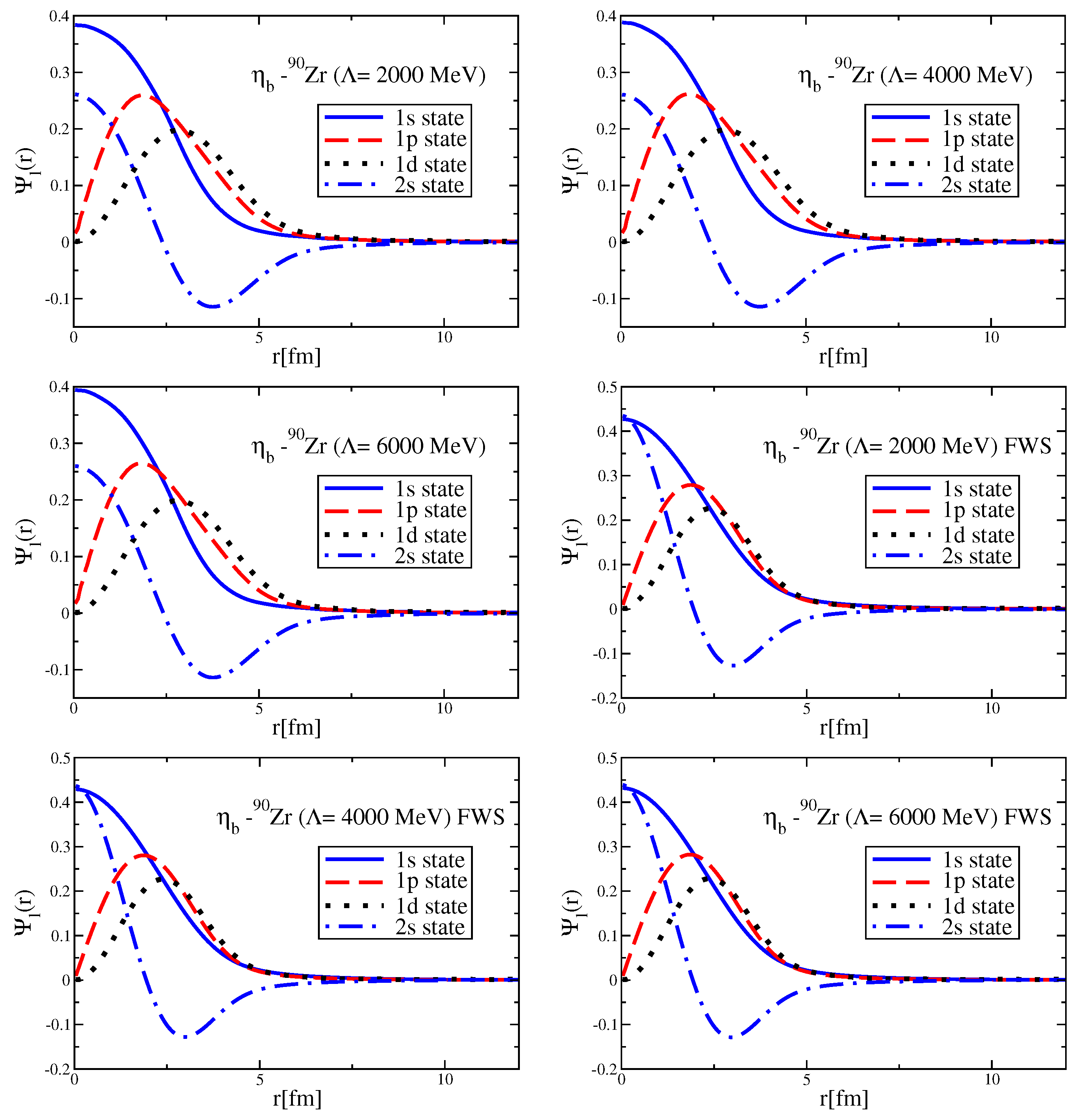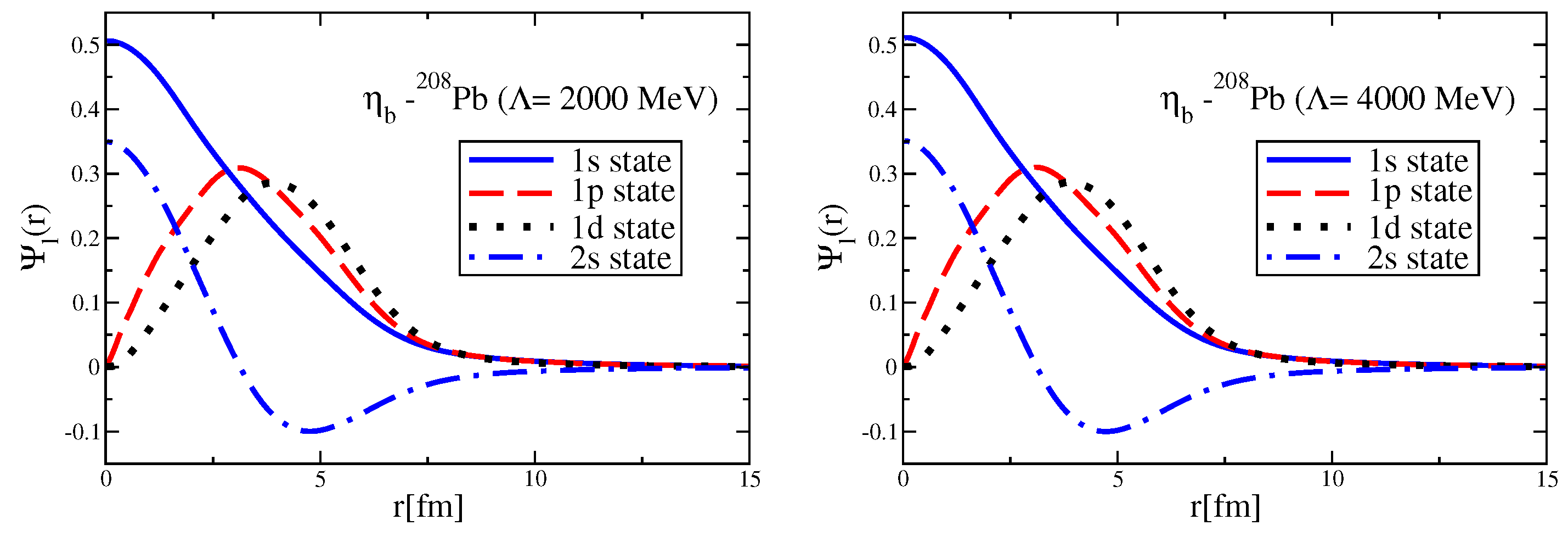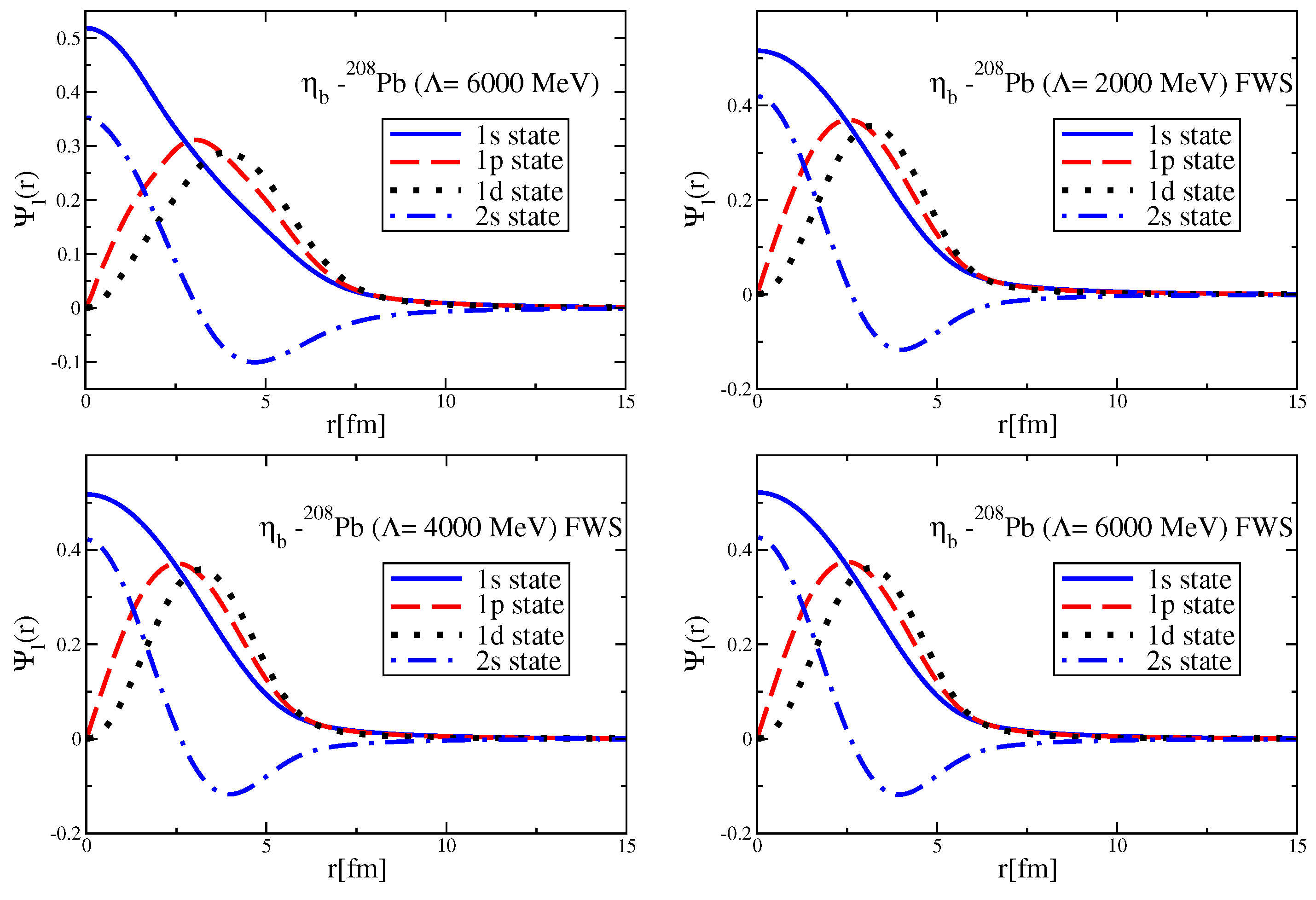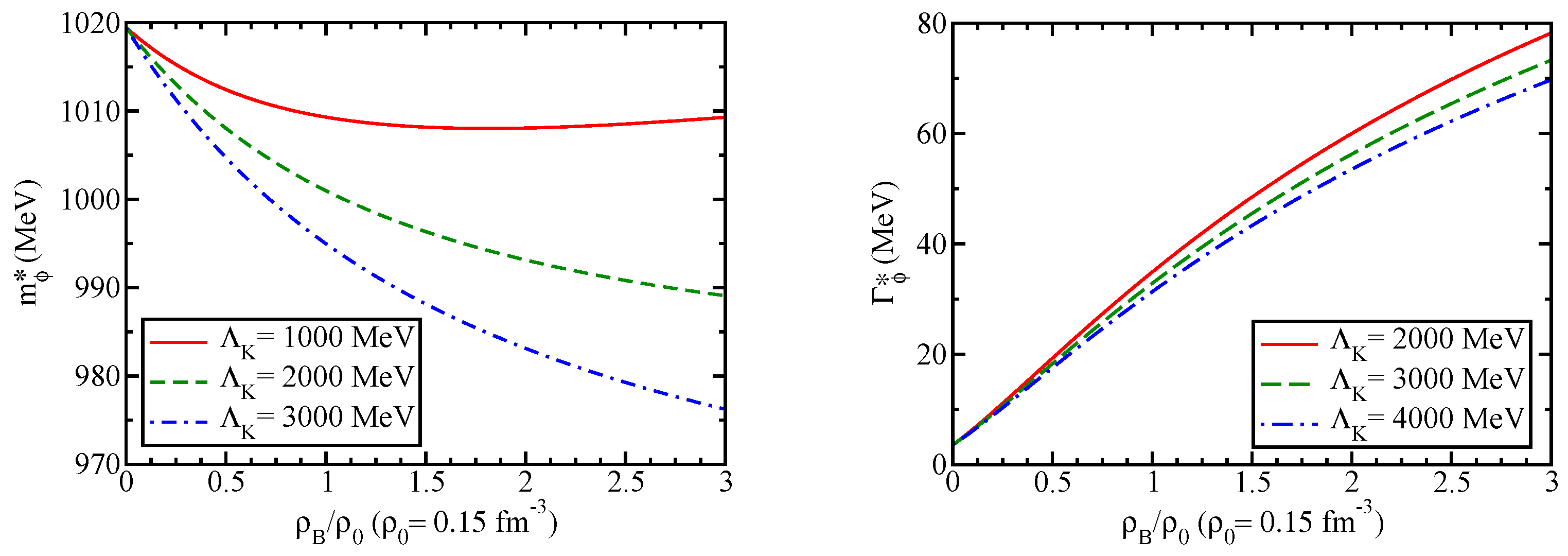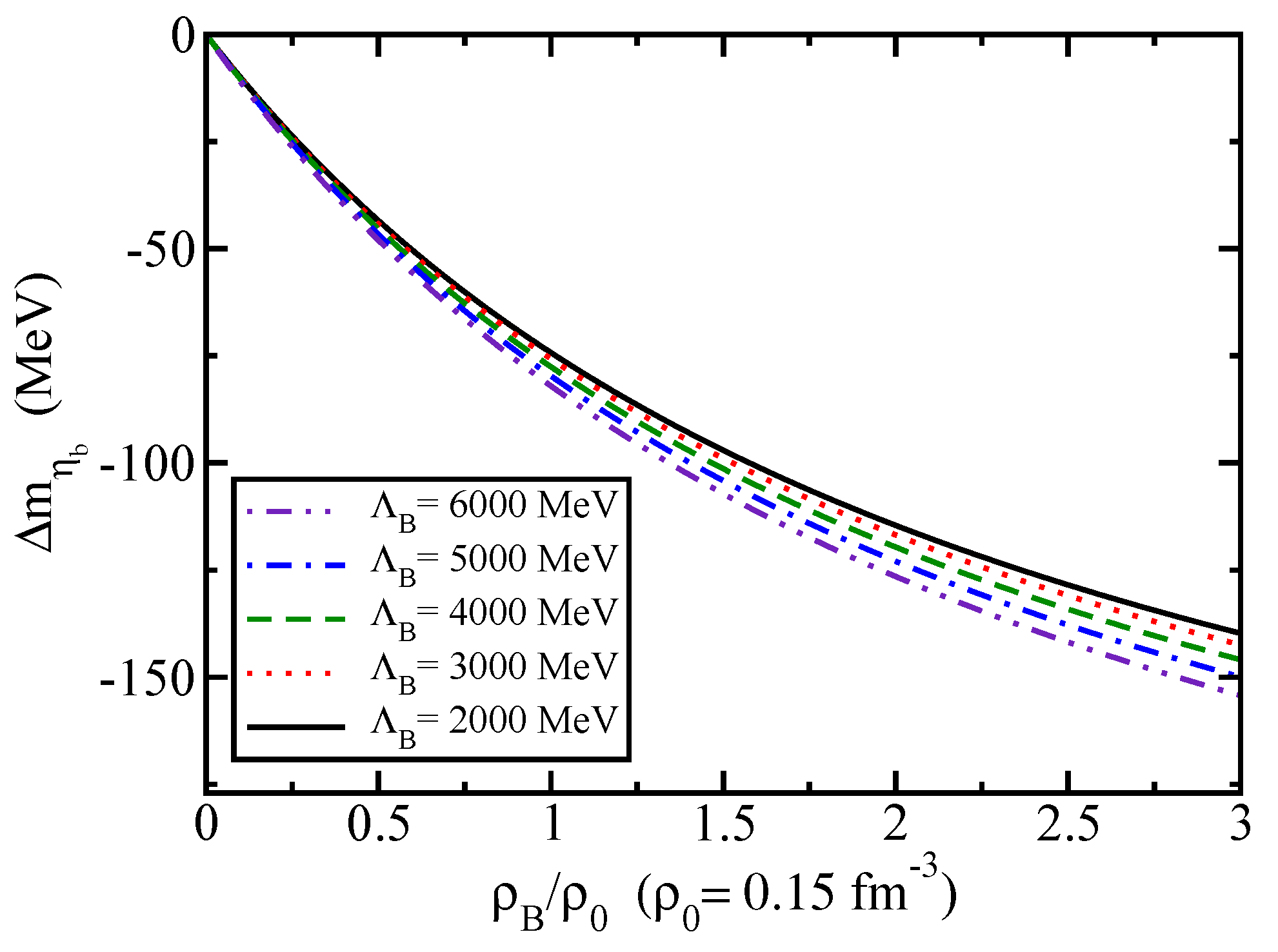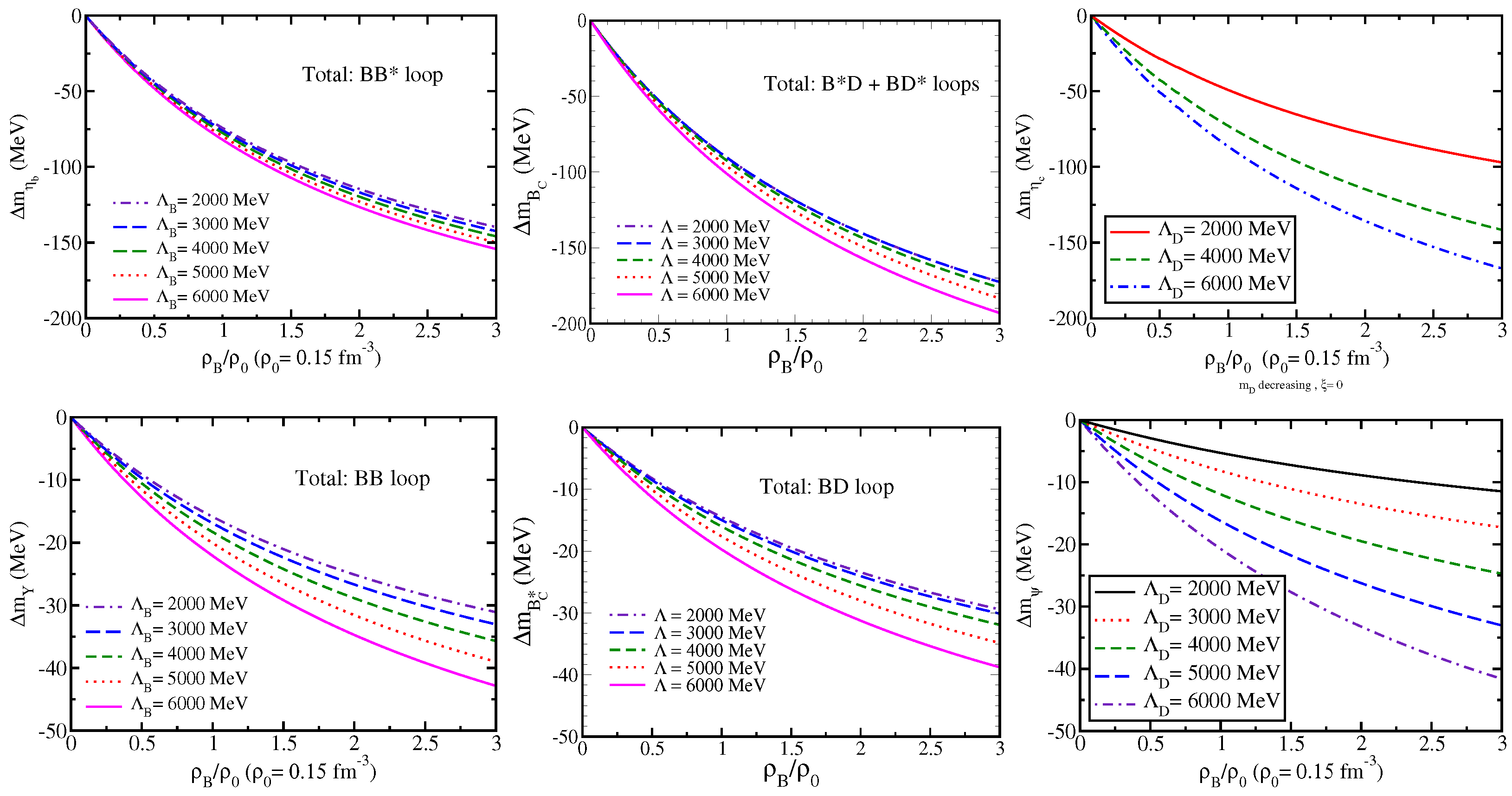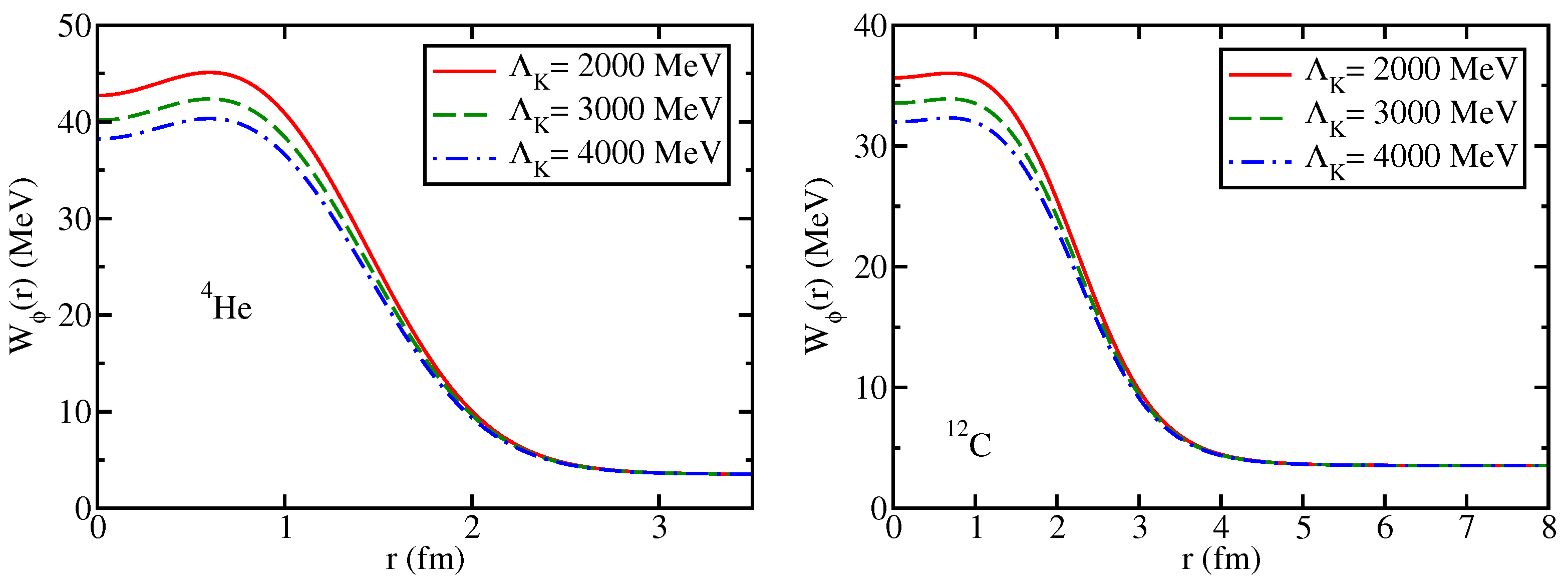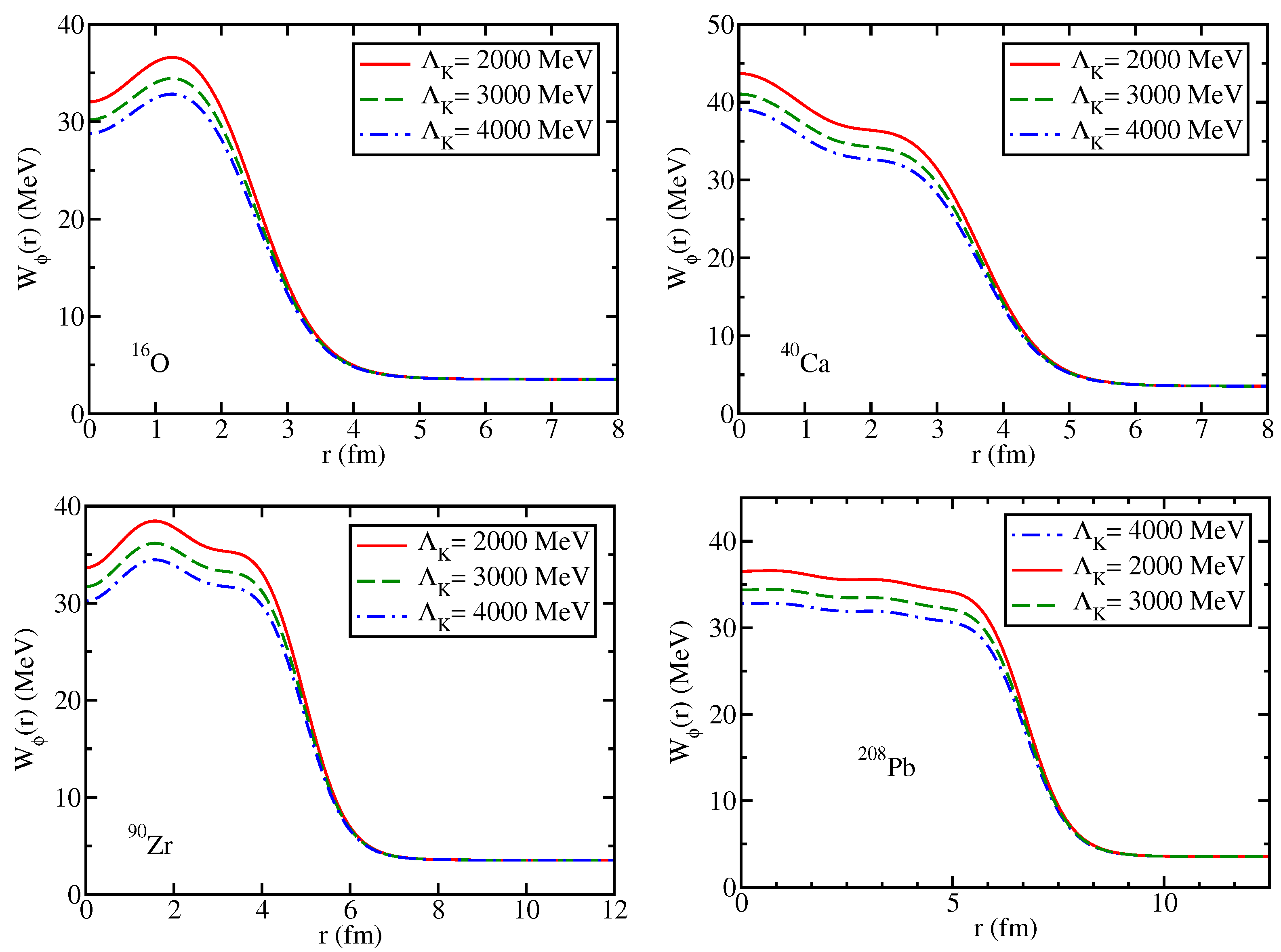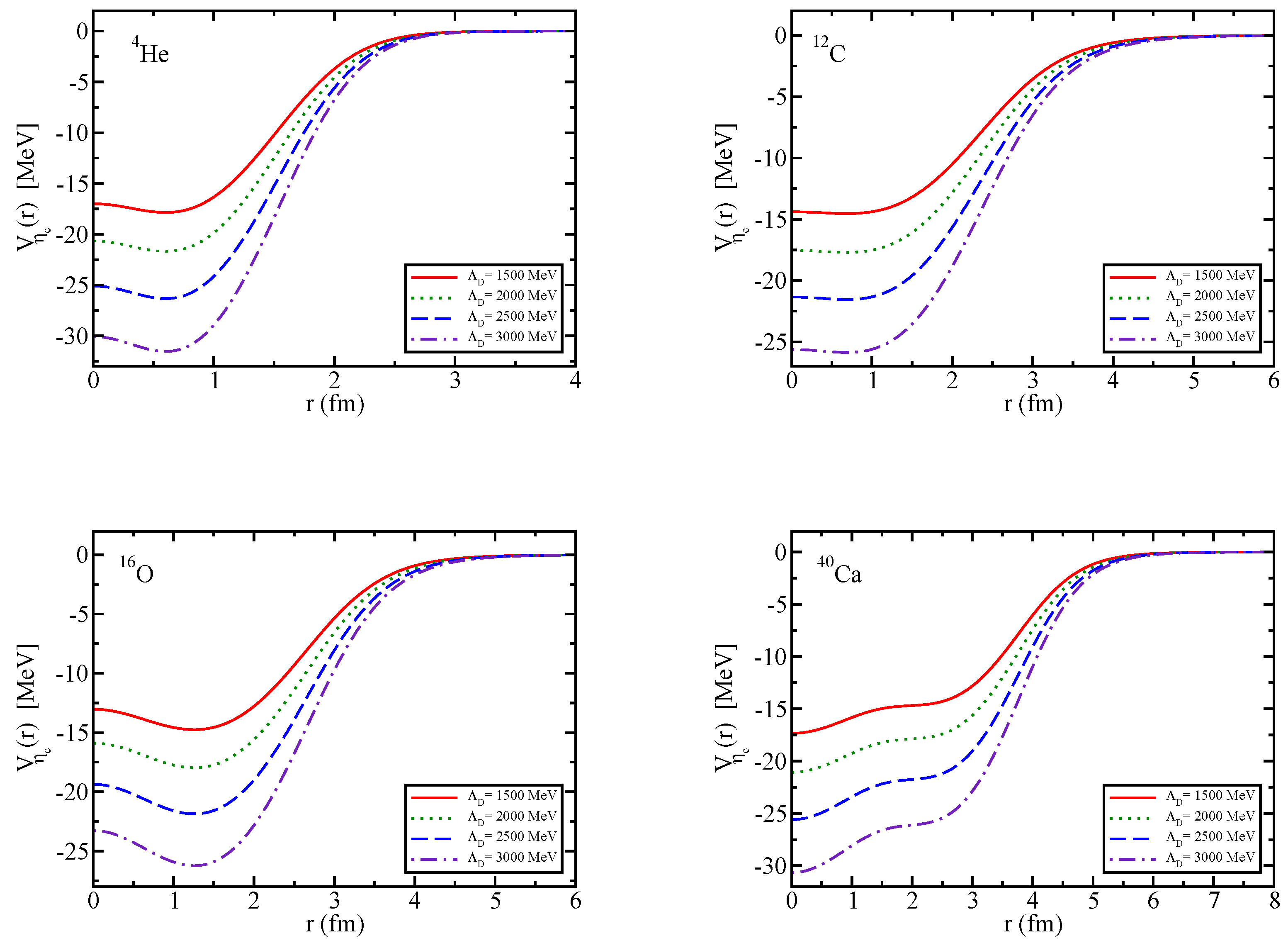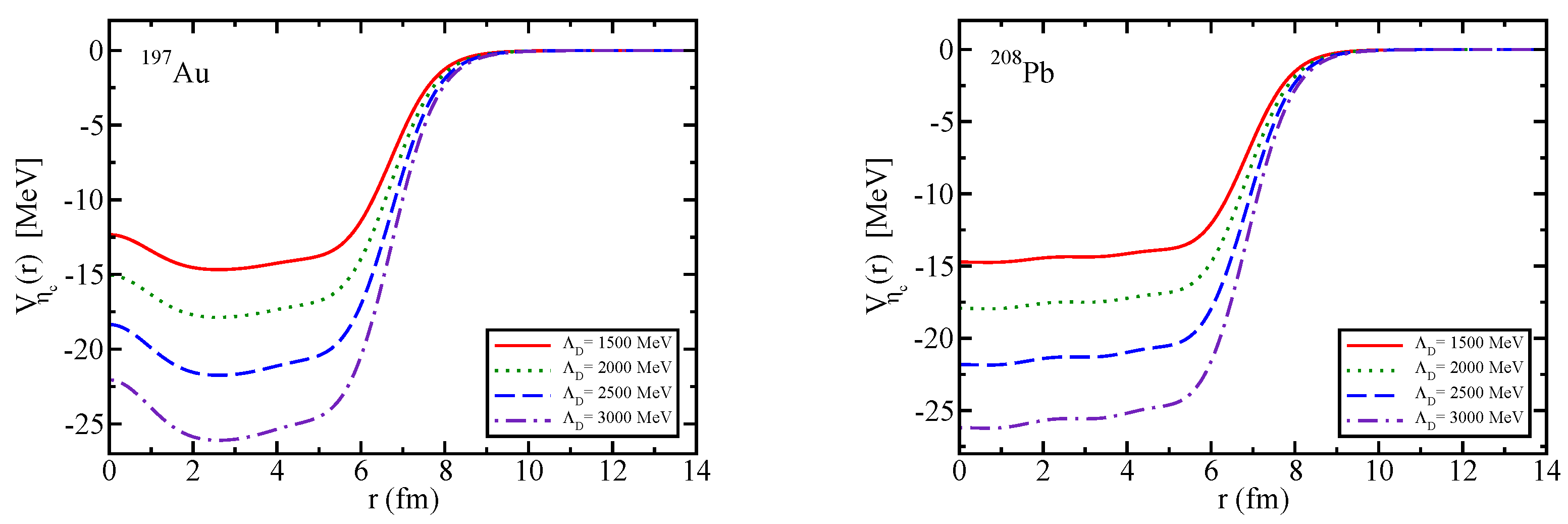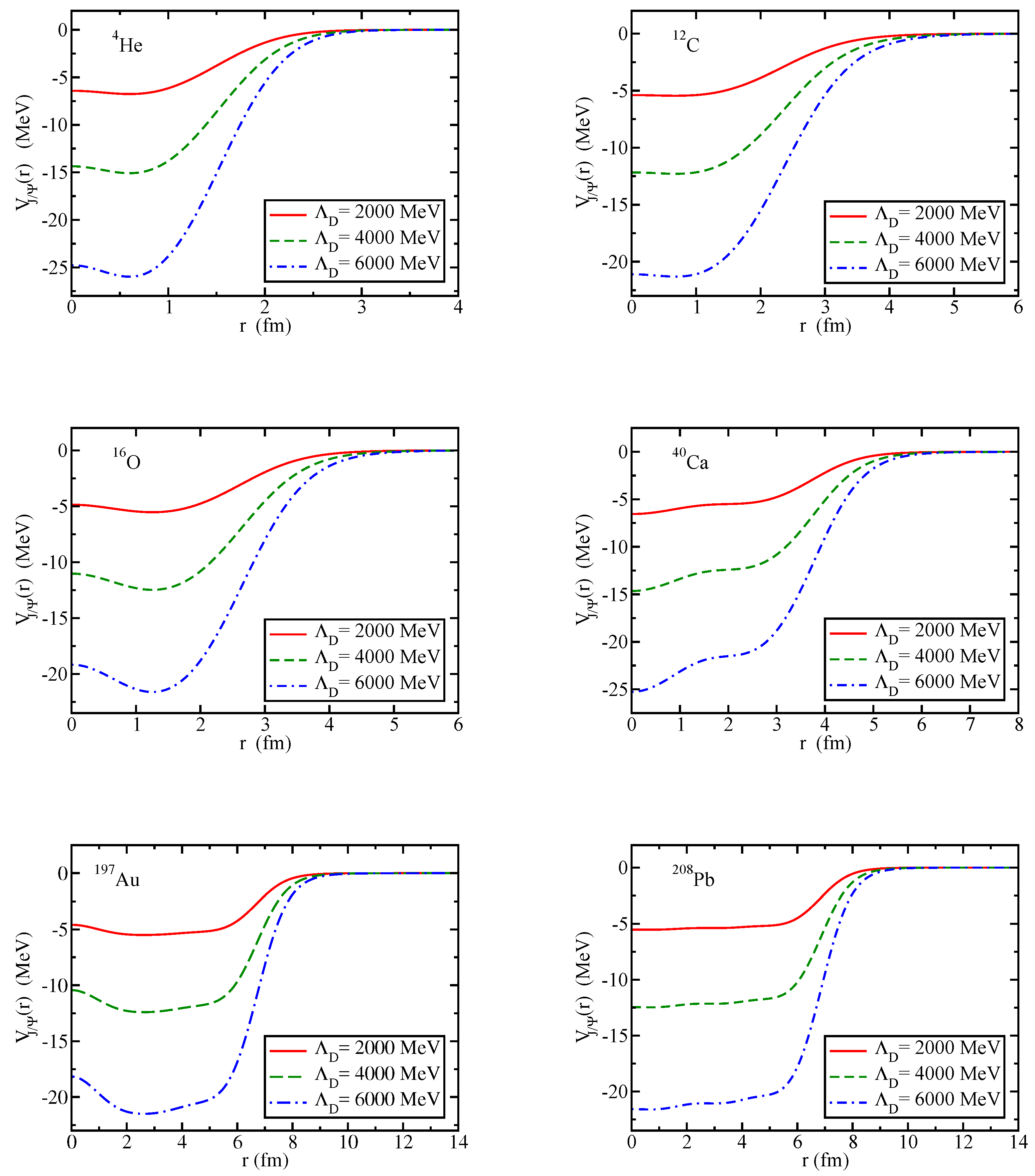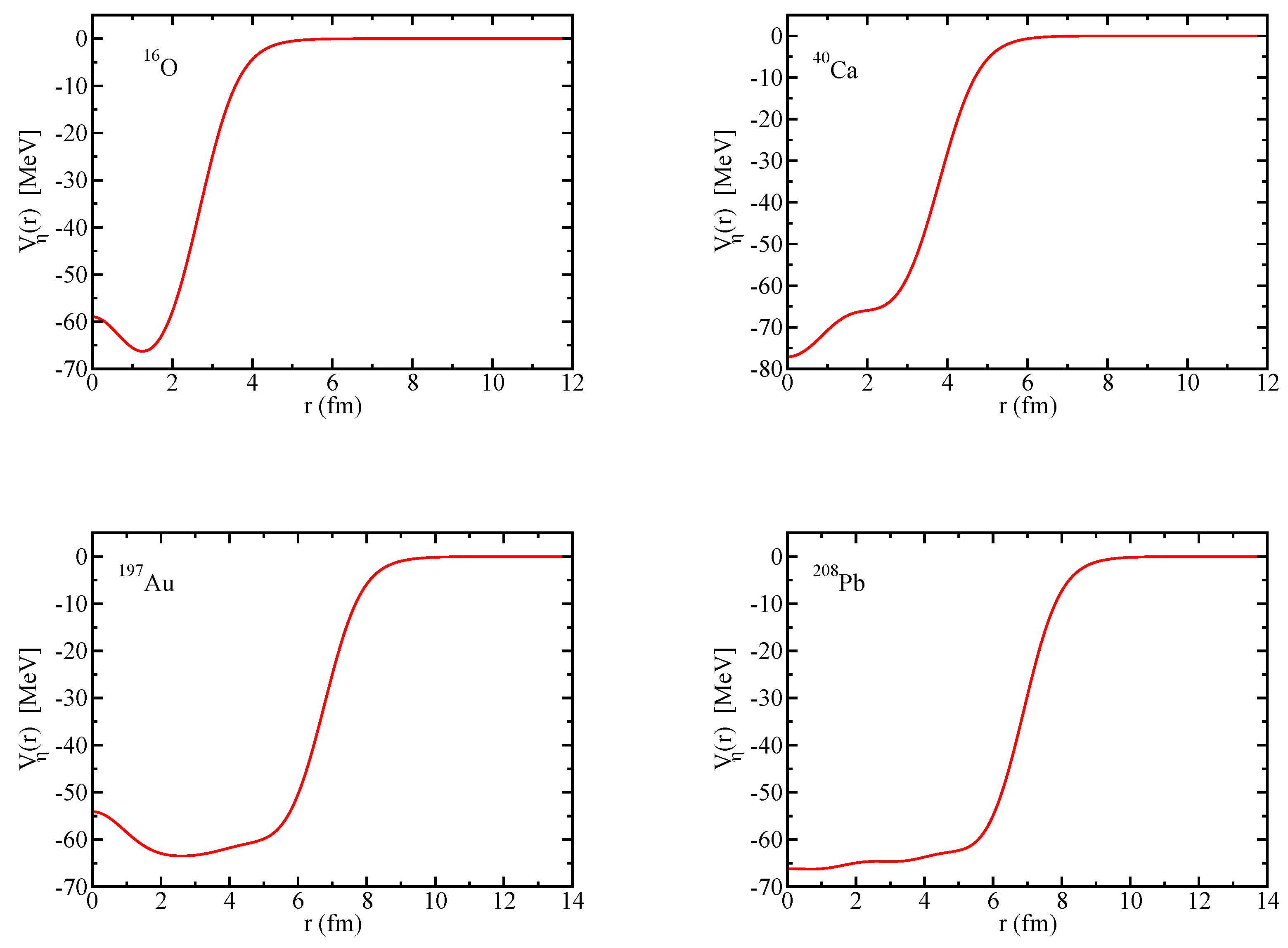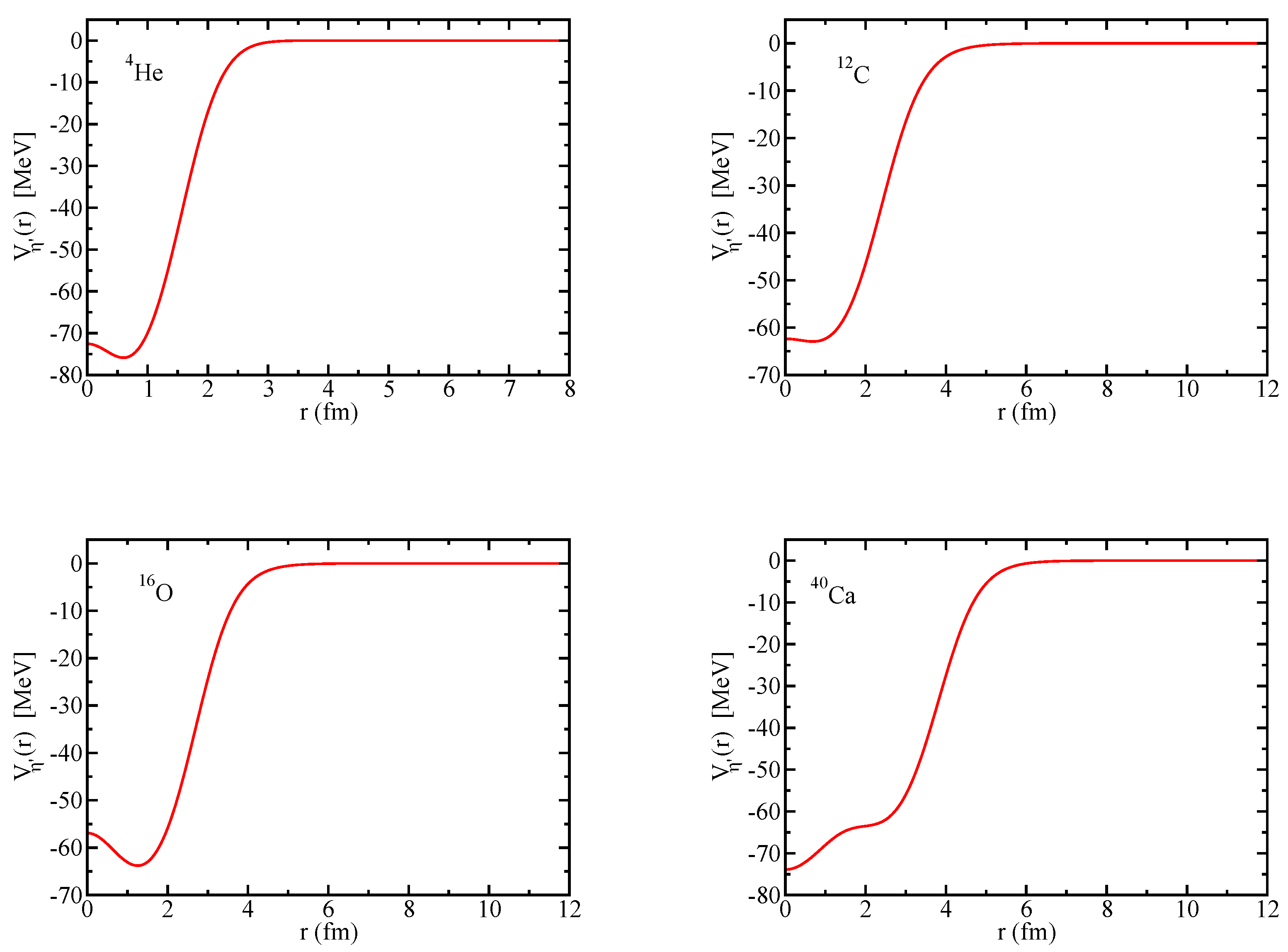Since the Okubo–Zweig–Iizuka rule suppresses the interactions mediated by the exchange of mesons made of light quarks for the case of heavy–heavy mesons, it is therefore necessary to explore other potential sources of attraction, which could potentially lead to the binding of heavy–heavy mesons to atomic nuclei. Furthermore, since the heavy quarks do not directly interact with the mean fields in a nuclear medium (see Equation (3)), to compute the effective masses (Lorentz scalar potentials) for the mesons composed of a (heavy quark)-(heavy antiquark) pair, we take a different approach.
This approach consists of the combined treatment with the QMC model and an effective Lagrangian. We have already introduced the QMC model above, so we now describe the effective Lagrangian approach we rely on.
4.1. The Vector Meson
The
meson properties in nuclear matter, such as mass and decay width, are strongly correlated to its coupling to the
, which is the dominant decay channel in vacuum. Therefore, the density dependence of the
meson self-energy in nuclear matter arises mainly due to interactions of the kaons and antikaons with the nuclear medium, and the kaon and antikaon in-medium properties are calculated in the QMC model [
91] (see also
Figure 1 for the effective mass of
K (=
) meson). Here we use the effective Lagrangian approach of Ref. [
107] to compute the
meson self-energy.
The lowest-order interaction Lagrangian providing the coupling of the
meson to the
pair reads [
107]
where
is
coupling constant and we use the convention:
The scalar self-energy for the
meson,
, is determined from Equation (
10). The Feynman diagram contributing to
at
is depicted in
Figure 3. For a
meson at rest, the scalar self-energy is given by
where
is the kaon propagator;
is the
meson four-momentum vector (
at rest), with
the
meson mass;
is the kaon mass. When
the self-energy
is real. However, when
, which is the case here,
acquires an imaginary part.
The mass of the
meson is determined from the real part of
(see Equation (
17)), while its decay width
to a
pair from the imaginary part of
through the optical theorem (see Equation (
15)). The real and imaginary parts of
can be computed as [
99]
where
denotes the Principal Value of the integral and
. The integral in Equation (
13) is divergent, but it will be regulated using a phenomenological form factor, with cutoff parameter
, as in Ref. [
42].
The decay width
for the process
can be obtained from the imaginary part of the
meson self-energy
through the optical theorem
where
is given by Equation (14). Thus, one obtains
The coupling constant
is determined by the experimental value for the
decay width in vacuum, corresponding to a branching ratio of
of the total decay width (4.266 MeV) [
108]. For the
meson mass
we use its experimental value in vacuum
MeV [
108]. For the kaon mass
, there is a small ambiguity since
in the real world due to the isospin (or charge) symmetry breaking and electromagnetic interactions. The experimental values for the
and
meson masses in vacuum are
MeV and
MeV, respectively [
108]. For definitiveness, we use the average of
and
as the value of
in vacuum. (However, the effect of this tiny mass ambiguity on the properties of kaon (antikaon) in medium, to be presented in the next section, is negligible compared with those obtained by using the value
MeV [
91]). This gives
[
99]. The mass of the
meson will be obtained from the solution of
where
is given by Equation (
13) and
is the bare
meson mass. In vacuum, Equation (
17), together with the value obtained for the coupling constant, actually fixes the bare
meson mass
.
Critical to our results of the in-medium
meson mass
and decay width
at finite baryon density
, is the in-medium kaon mass
. The nuclear (baryon) density dependence of the
meson mass and decay width are driven by the interactions of the kaon with the nuclear medium, which enter through
in the kaon propagators in Equation (
12). The in-medium kaon mass
was calculated previously in the QMC model, and the results are shown in the right panel of
Figure 1. We note that the kaon effective mass at normal nuclear density
fm
−3 decreases by about
[
99]. We remind that, to calculate the kaon-antikaon loop contributions to the
-meson self-energy in symmetric nuclear matter, the isoscalar-vector
mean field potentials arise both for the kaon and antikaon. However, they have opposite signs and cancel each other, or can be eliminated by the variable shift in the loop integral calculation.
To calculate the width and mass of the in-medium
meson,
and
, respectively, we solve the corresponding Equations (
16) and (
17) in symmetric nuclear matter by replacing
by
and
by
in the self-energy of the
meson. In
Figure 4, we present our results [
99] for the
meson mass (left panel) and decay width (right panel) in nuclear matter up to
. As can be seen in
Figure 4, the effect of the in-medium change in kaon mass gives a negative change in
meson mass. However, even for the largest value of density considered in this study, the downward mass shift is only a few percent for all values of the cutoff parameter
. In
Table 1, we present the values for
and
at normal nuclear density
. More quantitatively, from
Table 1 we see that the negative kaon mass shift of 13% induces only ≈ 2% downward mass shift of the
meson [
99]. On the other hand, from
Figure 4 we see that
is very sensitive to the change in the kaon mass. It increases rapidly with increasing nuclear density, up to a factor of ∼20 enhancement for the largest nuclear density considered,
[
99]. As can be seen from
Table 1, the broadening of the
meson decay width becomes an order of magnitude larger than its vacuum value at normal nuclear density.
4.2. and Mesons
The study of interactions of charmonium states, such as
and
, with atomic nuclei offers the opportunity to gain new insights into the properties of the strong force and strongly interacting matter [
72]. Because charmonia and nucleons do not share light quarks, the Okubo–Zweig–Iizuka (OZI) rule [
36,
37,
38,
39,
40] suppresses the interactions mediated by the exchange of mesons composed of light quarks and/or antiquarks. The situation here is similar to the
meson case and also generally for quarkonia and two-heavy-flavor mesons). Thus, it is important and necessary to explore other possible mechanisms, which can provide attractive (repulsive) interactions that could lead to the binding (unbinding) of charmonia to atomic nuclei [
72]. For a review on the subject, see Refs. [
8,
9,
10,
11]. Here, we employ an effective Lagrangian approach and consider charmed meson loops in the charmonium self-energy [
42,
43,
58,
72,
109]; that light quark-antiquark pair is created from the vacuum.
Note that, recent lattice study using the HAL QCD method with nearly realistic pion mass of
MeV, which was also able to reproduce well the physical hadron masses [
110,
111], found that the
N-
(
N-
and
N-
) interactions to be attractive in all distances. They predicted mass reduction of the
-meson at normal nuclear density of 0.17 fm
−3 of about 19(3) MeV. This is consistent with our prediction made without the “gauge term”, which is to be shown later.
For the computation of the
Lorentz scalar potential in nuclear matter, we use an effective Lagrangian approach at the hadronic level, which is an SU(4)-flavor extension of light-flavor chiral-symmetric Lagrangians of pseudoscalar and vector mesons [
107,
112]. When we treat the mesons that contain at least one bottom quark (antiquark), we will use an SU(5)-flavor Lagrangian [
31]. However, one can expect that the SU(5) flavor symmetry breaking is larger than that of SU(4) due to the current quark mass values of the charm and bottom quarks. Thus, for the SU(4) flavor sector, we use a flavor SU(4) effective Lagrangian, and determine the relevant coupling constants based on the flavor SU(4) symmetry.
We compute the
self-energy in vacuum and symmetric nuclear matter, following our previous works [
42,
43,
58,
99,
100,
102,
103,
104,
109], and consider only the
loop. See Ref. [
72] for details. The interaction Lagrangian density for the
vertex is given by
where
represents the
-meson field isospin doublet, and
is the coupling constant. The
self-energy in the rest frame of
meson,
is given by [
72]
where
and
, with
. The integral in Equation (
19) is divergent, and we regularize it with a phenomenological vertex form factor
with cutoff parameter
, as in previous works. See Ref. [
72] and references therein. Thus, to regularize Equation (
19), we will introduce the form factor
into the integrand. As before, the cutoff parameter
is an unknown input to our calculation (we use
). However, it may be fixed phenomenologically, for example, using a quark model. In Ref. [
42], the value of
has been estimated to be
MeV, and serves as a reasonable guidance to quantify the sensitivity of our results to its value. Therefore, we vary it over the interval 1500–3000 MeV [
72].
Because the flavor SU(4) symmetry is strongly broken (though less than that of SU(5),we use the experimental values for the meson masses [
108] and known (extracted) empirical values for the coupling constants, as explained in the following. For the
D meson mass, we take the averaged masses of the neutral and charged states, and similarly for the
. Thus
MeV and
MeV. For the coupling constants,
was obtained in Ref. [
113], as the residue at the poles of suitable form factors using a dispersion formulation of the relativistic constituent quark model, where
was estimated in Ref. [
114] using the vector meson dominance (VMD) model and isospin symmetry. In this study we use the coupling constant,
[
72], where the factor (
) is introduced to give a larger SU(4) symmetry breaking effect than Ref. [
113].
In this subsection, we will show the mass shift of with the use of both the SU(4) symmetry coupling constant as well as that with the broken SU(4) coupling constant. Furthermore, later we will compare the in-medium masses of and with those of the and , using the coupling constant value , without any symmetry breaking factor, i.e., , where the tiny difference may be ignored. For the mass shift in this subsection, after the mass shift, we will use only the SU(4) symmetric coupling constant, .
We are interested in the difference between the in-medium,
, and vacuum,
, masses of the
,
with the masses obtained self-consistently from
where
is the bare
mass and the
self-energy in the rest frame of
meson,
is given by Equation (
19). The
-dependent
-meson bare mass,
, is fixed by fitting the physical
-meson mass,
MeV [
72].
The in-medium
mass is obtained in a similar way, with the self-energy calculated with the medium-modified
D and
meson masses. The nuclear density dependence of the
-meson mass is influenced and determined by the intermediate-state
D and
meson interactions with the nuclear medium through their medium-modified masses. The in-medium masses
and
are calculated within the quark–meson coupling (QMC) model [
42,
43], in which effective scalar and vector meson mean fields couple to the light
u and
d quarks in the charmed mesons [
42,
43].
In the middle panel of
Figure 1 we present the resulting medium-modified masses for the
D and
mesons, calculated within the QMC model [
42], as a function of
, where
is the baryon density of nuclear matter and
fm
−3 the saturation density of symmetric nuclear matter. The net reductions in the masses of the
D and
mesons are nearly the same as a function of density, with each decreasing by about 60 MeV at
. The behavior of the
D meson mass in medium (finite density and/or temperature) has been studied in a variety of approaches, where some of these [
115,
116,
117] find a decreasing
D meson mass at finite baryon density, while others [
118,
119,
120,
121,
122], interestingly, find the opposite behavior. However, it is important to note that none of the studies in nuclear matter are constrained by the saturation properties of nuclear matter, despite the fact that they are constrained in the present work. Furthermore, some of these works employ a non-relativistic approach, where relativistic effects might be important.
In
Figure 5, we present the
-meson mass shift,
, as a function of the nuclear matter density,
(
), for four values of the cutoff parameter
[
72]. As can be seen from the figure, the effect of the in-medium
D and
mass changes is to shift the
mass downwards. This is because the reduction in the
D and
masses enhances the
-loop contribution in nuclear matter relative to that in vacuum. This effect increases the larger the cutoff mass
becomes.
The results described above with the two values of the
coupling constants, both support a small downward mass shift for the
in nuclear matter, and open the possibility to study the binding of
meson to nuclei [
72].
We now turn to the discussion of the
vector meson [
105,
106], following the same procedure as in the
meson. In Refs. [
11,
42,
43], the
self-energy intermediate states involved the
D,
,
, and
mesons. However, it was found that the
self-energy has larger contributions from the loops involving the
and
mesons, which is unexpected; see Refs. [
11,
42,
43] for details on the issues and possible explanations. As explained in Ref. [
11], this is related to the divergent behavior of the vector meson propagator. We present results for the
mass shift in nuclear matter and nuclei considering only the lightest intermediate state mesons in the
self-energy, namely the
loop [
105,
106].
We use the following phenomenological effective Lagrangian densities at the hadronic level, which are similar to those used above for the
-meson,
where
is the
coupling constant and we use the convention
For notational simplicity, we have written
to denote the field representing the
vector meson. We note that the Lagrangians are an
(4) extension of light-flavor chiral-symmetric Lagrangians of pseudoscalar and vector mesons. In the light flavor sector, they have been motivated by a local gauge symmetry, treating vector mesons either as massive gauge bosons or as dynamically generated gauge bosons. Local gauge symmetry implies the contact interaction in Equation (26) involving two pseudoscalar and two vector mesons.
In view of the fact that
(4) flavor symmetry is strongly broken in nature, and in order to stay as close as possible to phenomenology, we use the experimental values for the charmed meson masses and use the empirically known meson coupling constants. For these reasons, we do not use gauged Lagrangians for the study of
nuclear bound states—a similar attitude was followed in Ref. [
112] in a study of hadronic scattering of charmed mesons. However, in order to compare results with Ref. [
57] and assess the impact of a contact term of the form Equation (26), we also present results for the
mass shift including such a term.
We are interested in the difference of the in-medium,
, and vacuum,
,
with the masses obtained from
Here
is the bare mass and
is the total
self-energy obtained from the
-loop contribution only. The in-medium mass,
, is obtained likewise, with the self-energy calculated with medium-modified
D meson mass calculated by the QMC model (see again the middle panel of
Figure 1).
The scalar self-energy for the
meson in the rest frame of
,
, is obtained from Equation (
24). The Feynman diagram contributing to
self-energy
is identical to the one in
Figure 3 with the replacements
,
and
.
For a
meson at rest, the self-energy is given by
where
, and
is the product of vertex form-factors with
and
given as in Equation (
21) with cutoff parameters
and
, respectively (we use
); and
for the
loop contribution is given by
where
,
for the non-gauged Lagrangian of Equation (
24) and
with Equation (26), for the gauged Lagrangian of Ref. [
57].
As before, the cutoff parameter
is an unknown input to our calculation. However, it may be fixed phenomenologically. In Ref. [
42] the value of
has been estimated to be
MeV, and serves as a reasonable guidance to quantify the sensitivity of our results to its value. Since this is a somewhat rough estimate, and it is made solely to obtain an order of magnitude estimate, we allow the value of
vary in the range
; see Refs. [
11,
42,
43].
The bare
mass
and the coupling constants remain to be fixed. The bare mass is fixed by fitting the physical mass
MeV using Equation (
29). is strongly broken, we use experimental values for the meson masses and known empirical values for the coupling constants. For the
D meson mass, we take the averaged masses of the neutral and charged
D mesons. Thus
MeV [
108]. For the coupling constants, we use
, which is obtained by the use of isospin symmetry [
114]. Note that, for
, we use only the SU(4) coupling constant extracted, different from that of the
case (no extra SU(4) breaking effect on the coupling constant).
The nuclear density dependence of the
-meson mass is influenced and determined by the intermediate-state
D and
meson interactions with the nuclear medium through their medium-modified masses. The in-medium masses
and
are calculated within the quark–meson coupling (QMC) model [
42,
43], in which effective scalar and vector meson mean fields couple to the light
u and
d quarks in the charmed mesons [
42,
43]. However, in the self-energy of the
loop, the vector potentials cancel out, and there is no need to consider the effects.
Again, see the middle panel of
Figure 1; we present the medium-modified masses for the
D and
mesons (
), calculated within the QMC model [
42] as a function of
. In
Figure 6, we show the contribution of the
-loop to the
mass shift for
. As the cutoff mass value increases in the form factor, the
-loop contribution obviously becomes larger.
First, from the result shown in the left panel of
Figure 6 without the gauge term (
), one can see that the
obtains the attractive potential for all the values of the cutoff
, 2000–6000 MeV [
105,
106]. In contrast, one can see from the right panel in
Figure 6, that the effect of the gauge term tends to oppose the effect (repulsion) of the contribution of the
-loop as noticed in Refs. [
42,
105,
106]. When the value of
is smaller, the mass shift actually becomes positive. The results shown in
Figure 6 reveal a negative mass shift (attractive potential) for the
meson in symmetric nuclear matter for all values of the cutoff mass parameter
when
and, as in the
meson case, open the possibility to study the binding of
mesons to nuclei [
105,
106].
4.3. and Mesons
First, we discuss the
(vector) meson. The
mass shift in nuclear matter originates from the modifications of the
,
, and
meson loops contributions to the
self-energy, relative to those in free space; the lowest order Feynman diagrams associated with these contributions are similar to
Figure 3. The
self-energy is calculated using an effective SU(5)-flavor symmetric Lagrangian at the hadronic level [
31,
77], where mesons are considered to be point like, for the interaction vertices
,
, and
neglecting any possible imaginary part. In Ref. [
77] we made an extensive analysis of these contributions to the
self-energy and found that, for example, the
loop gives an unexpectedly large contribution, similar to the case of
. For this reason, and to be consistent with the
case studied below, we consider only the
loop contribution to the
self-energy [
77], leaving for the future a full study of all three contributions. This treatment is also consistent with the
self-energy calculation with the lowest
loop contribution, and we can compare the amounts of mass shift for the
and
based on a similar footing. The interaction Lagrangian for the
vertex is given by [
77]
where
is the coupling constant for the vertex
vertex, and the following convention is adopted for the isospin doublets of the
B mesons
The coupling constant
is calculated from the experimental data for
using the vector meson dominance (VMD) model. This gives
; see Refs. [
31,
77] and references therein for details. We note that a similar approach was taken in Refs. [
42,
114] to determine the coupling constant
for the vertex
.
Including only the
loop, Equation (
32), the
self-energy
for an
at rest is given by [
77]
where
with
and
. As is always the case in an effective Lagrangian approach, when mesons are treated as point-like particles, the self-energy loop integrals like Equation (
33) are divergent and therefore need to be regularized. To this end, we introduce into the integrand of Equation (
33) a phenomenological vertex form factor
with cutoff parameter
[
42,
43,
58,
99,
100,
102,
103,
104,
109], for to each
vertex, as we did in previous cases; see Equation (
21). We recall that form factors are necessary to take into account the finite size of the mesons participating in the vertices, while the cutoff
, which is an unknown input to our calculation, may be associated with energies needed to probe the internal structure of the mesons. Thus, in order to reasonably include these effects, and to quantify the sensitivity of our results to its value, we vary
over the interval 2000–6000 MeV (roughly up to around the mass of the
B meson); see Ref. [
77] for a more extensive discussion.
The
mass shift in nuclear matter,
, is calculated from the difference between its mass in the medium,
, and its value in vacuum,
, in the rest frame of the
, namely,
where these masses are computed self-consistently from
with
the bare
mass and the
self-energy
is given in Equation (
33). The
-dependent
bare mass,
, is fixed with the physical
mass, namely
MeV.
The in-medium
mass
is obtained by solving Equation (
36) with the self-energy calculated with medium-modified
B mass. This medium-modified mass was calculated using the quark–meson coupling (QMC) model as a function of the nuclear matter density
, and the results are shown in
Figure 1 (left panel). From
Figure 1, it can be seen that the QMC model gives a similar downward mass shift for the
B and
in symmetric nuclear matter. For example, at the saturation density
, the mass shift for the
B and
mesons are respectively,
MeV and
MeV, where the difference in their mass shift values appears in the decimal place. The values for the masses in vacuum for the
B and
mesons used are
MeV and
MeV, respectively.
The nuclear density dependence of the
mass is driven by the intermediate
state interactions with the nuclear medium, where the effective scalar and vector meson mean fields couple to the light
u and
d quarks in the bottom mesons,
B and
. In
Figure 7 we show the results for the
mass shift as a function of the nuclear density,
, for five values of the cutoff parameter
. As can be seen in
Figure 1 (left panel) and
Figure 7, a decrease in the in-medium
B meson mass induces a negative mass shift for
. As expected, the mass shift amount of the
is dependent on the value of the cutoff mass
used, being larger for larger
; see Ref. [
77] for further details. For example, for the values of the cutoff shown in
Figure 7, the
mass shift amount varies from −16 to −22 MeV, at
.
For the calculation of the
mass shift in nuclear matter, we proceed similarly to the
case and take into account only the
loop (pseudoscalar-pseudoscalar-vector) contribution to the
self-energy. In Ref. [
77], we have also studied the mass shift, including the
interaction in the
self-energy, and found that its contribution to the mass shift amount turned out to be negligible. Thus, in order to be consistent with the
case above, in both cases we consider only the minimal contribution, and here we only give results for the
loop in the
self-energy. This is also a consistent treatment with the
mass shift calculation, and later we can compare based on a similar footing of the self-energy calculation.
For the calculation of the
mass shift in symmetric nuclear matter, we proceed similarly to the
and
cases, and take into account only the
loop contribution to the
self-energy. As already mentioned, in Ref. [
77], we have also studied including the
interaction in the
self-energy and found that its contribution to the mass shift amount is negligible.
The effective Lagrangian for the
interaction is [
77]
where
is the coupling constant for the
vertex. We will use its value in the SU(5) scheme [
77], namely
. Using Equation (
37), the
self-energy for an
at rest is given by [
72]
where
with
and
. The mass of the
meson, in vacuum and in nuclear matter, is computed similarly to the
case [
77]. First, we introduce form factors, as in Equation (
21), into each
vertex, with
, to regularize the divergent integral in the self-energy Equation (
38). Second, we fix the value of the
bare mass using the physical (vacuum) mass of the
, namely
MeV, using Equation (
36) appropriately written for the
case. Then, for the calculation of the
mass shift in nuclear matter, the self-energy
is computed using the medium-modified
B and
masses calculated with the QMC model and shown in
Figure 1 (left panel). The results for the
mass shift behavior in nuclear matter are shown in
Figure 8 as a function of the nuclear matter density
, for the same range of values for the cutoff mass
as for the
[
77]. As can be seen from
Figure 8, the mass of the
is shifted downwards in nuclear matter for all values of the cutoff
, similarly to the
. For example, at the normal density of symmetric nuclear matter
, the mass shift value varies from −75 MeV to −82 MeV when the cutoff varies from
MeV to
MeV. Similarly to the
mass shift, the dependence of the
mass shift amount on the values of the cutoff is small, for example, just −7 MeV when the cutoff is increased by a factor of 3 at
[
77].
4.4. and Mesons
The
(
) in-medium downwards mass shift comes from the enhanced
(
) loop contribution to the self-energy, relative to those in free space. See
Figure 3 but replacing the
loop properly by
and
loops (
loop). See Ref. [
90] for details. By expanding the SU(5) flavor symmetric effective meson Lagrangian [
31] in terms of the components of pseudoscalar (
P) and vector (
V)
matrices, we obtain the following Lagrangians for the interactions
,
and
[
90]:
where the conventions for the
and
mesons have been already given.
The SU(5) symmetric universal coupling
g yields the relations,
. The value of
g is fixed by
by the
decay data
with the vector meson dominance (VMD) model [
31,
77], and thus we obtain,
The in-medium mass shift of the
meson,
, is computed by the difference of the in-medium
and the free space
masses
where, the free space mass
(input) is used to determine the bare mass
by
Note that the total self-energy
is calculated by the sum of the
and
meson loop contributions in free space, ignoring the possible
meson as well as all the other meson widths (or imaginary part) in the self-energy. The in-medium
mass
is similarly calculated, with the same bare mass value
determined in free space, and the in-medium masses of the (
) mesons (
), namely,
We note that, when the self-energy graphs contain different contributions, as
,
depends on both
and
to reproduce the physical mass
. Thus, one must be careful when discussing the
in-medium mass and mass shift of each loop contribution
and
, since
, and
. The dominant loop contribution can be known by the decomposition of the self-energy
. It turned out that the dominant contribution is from the
loop [
90]. This is due to the dominant contribution from the lighter vector meson
due to the vector meson propagator Lorentz structure.
As an example, in the case considering solely the
loop without the
loop, the “in-medium”
self-energy in the rest frame of
is given by
with
, and
is expressed, after the Cauchy integral with respect to
complex plane shifting
variable for the vector potentials as,
where,
in Equation (
46) is the product of vertex form factors in medium to regularize the divergence in the loop integral,
. They are given by using the corresponding meson in-medium masses,
and
with
and
being the cutoff masses associated with the
and
D mesons, respectively. We use the common value
. A similar calculation is performed to obtain the
loop contribution, namely, in Equations (
46) and (
47), as well as in the form factors, by replacing
.
The choice of cutoff value has no negligible impact on the results. We use the common cutoff
by varying the
value. The
value may be associated with the energies to probe the internal structure of the mesons. In the previous study [
77], it was observed that when the values of the cutoff become close to the masses of the mesons in calculating the self-energies, a certain larger cutoff mass value range did not make sense to serve as the form factors. This is because the Compton wavelengths of the corresponding cutoff mass values reach values near and/or smaller than those of the meson sizes. Therefore, we need to constrain the cutoff
value in such a way that the form factors reflect properly the finite size of the mesons. Based on the heavy quark and heavy meson symmetry, we use the same range of values for
as it was practiced for the quarkonia [
77]. Thus, we use the values,
= 2000, 3000, 4000, 5000, and 6000 MeV.
The mass shift amount at , which includes the total () loop contributions, ranges from −90.4 to −101.1 MeV ( 6184.1 to 6173.4 MeV). Later, we will compare the mass shift and those of the and .
Next, we study the in-medium mass shift of the
meson calculated in the rest frame of
. For the
self-energy, we include only the
loop contribution, as already commented based on the
and
self-energies [
77],
where
is expressed by,
with
. In Equation (
48),
is given by the product of the form factors,
, with
and
being
and
. Again we use
ranging 2000 to 6000 MeV.
4.5. Comparison with Heavy Quarkonia
We now compare in
Figure 9 the results of
and
[
90], with those of the heavy quarkonia [
11,
42,
72,
77]. Since the
meson is a pseudoscalar meson, we compare with the bottomonium
and charmonium
(upper panel), while for the
meson, we compare with those of the
and
(lower panel).
For the comparison, we would like to emphasize that we use the empirically extracted SU(4) sector coupling constants for the charm sector ( and ), which would be more reasonable than using the empirically extracted SU(5) sector coupling constant from the , since the SU(5) flavor symmetry breaking is expected to be much larger than that of the SU(4) based on the quark masses.
The value for the coupling constant of the vertex
used in the calculation of
mass shift, was obtained from the experimental data for
by the VMD hypothesis (note that the slight difference, 7.64 → 7.7 below, but the difference is negligible)
where
g is the universal SU(4) coupling constant.
For the coupling constant
used in the calculation of the
mass shift, we also adopt the SU(4) symmetry for the charm sector, which gives the relation
A comprehensive list of the values used for the coupling constants is presented in
Table 2.
Although we make this comparison, we repeat that this is not made based on a rigorous SU(5) symmetry of the same footing. Namely, the coupling constant g is calculated for the charm sector (, ) based on the SU(4) symmetry, and for the bottom sector (, ) and (, ) based on the SU(5) symmetry. This comparison would make sense based on the fact that SU(5) symmetry is much more broken by the quark masses than that of SU(4).
Note that, although for the mass shift amount
[
72], the cutoff mass values
and 5000 MeV are missing, it is irrelevant to see the mass shift range for the cutoff range between the 2000 MeV and 6000 MeV.
In the study of the mass shift, only the loop contribution was included, and it corresponds to the mass shift value at ranges −49.2 to −86.5, for the cutoff mass values of 2000, 4000, and 6000 MeV. The estimated values for the mass shift at including only the loop, ranges from −74.2 to −82.0 MeV, where the same range of the cutoff mass value is applied for the present study. The total loop contributions for the mass shift give a more negative mass shift than those of the and . This fact indicates that the mass shift value does not show the middle range mass shift value between those of the and , which may be different from one’s naive expectation.
Next, we compare the mass shift behaviors of
and
in
Figure 9 (lower panel). The
and
mass shift values are calculated by taking, respectively, only the (minimal)
and
loop contributions corresponding to the present
meson treatment with only the
loop. The mass shift value
at
ranges from −15.9 to −22.1 MeV, while
at
ranges from −5.3 to −20.7, when the common range of the
(2000 to 6000 MeV) is used. The corresponding
mass shift value
at
ranges from −14.5 to −19.7 MeV. The
meson in-medium mass shift value is less dependent on the cutoff mass value than that of the
. Although the mass shift behavior depends on the cutoff mass value, the global trend shown in the lower panel of
Figure 9 indicates that
is more or less in the middle of the corresponding
and
.

